David Tallerman's Blog, page 9
September 28, 2020
Drowning in Nineties Anime, Pt. 81
Well, whether or not it would, that's apparently what the fates have handed us, in the shape of Sea Prince and the Fire Child, Voltron: Fleet of Doom, Ai City, and Space Warrior Baldios: The Movie...
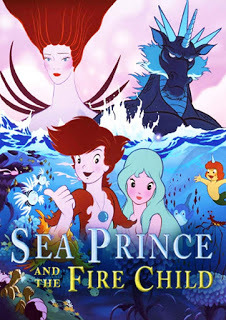 Sea Prince and the Fire Child, 1981, dir: Masami Hata
Sea Prince and the Fire Child, 1981, dir: Masami HataFor what's unquestionably intended to be a children's film, Sea Prince and the Fire Child is awfully concerned with sex and death. And not just any sex; this is that rare children's film that decides that what youngsters are eager to learn about is the heady notion of incest. It's right there from the beginning, as we discover that the goddess of fire and the god of water, who happen to be brother and sister, used to be decidedly intimate until Argon, Lord of the Winds, wrenched them apart with a few well-placed rumours. Soon they've isolated themselves, one on the land and one in the sea, with their two kingdoms divided by a rift of enmity that no-one dares cross. That is, until the sea god's son Syrius happens to stumble across the fire goddess's daughter Malta and the pair fall instantly in lust - quite explicitly so for what, let's reiterate, is very definitely a film intended for children. If you've been following along so far, it's perhaps occurred to you that Syrius and Malta are also quite possibly brother and sister.
From there, events proceed much as you might expect, if what you were expecting was a kiddified Romeo and Juliet with Verona replaced by a world of mythological anthropomorphism and adorable sea creatures. And frankly, it's difficult to know what to do with any of this, especially once things get very dark indeed toward the final third. I suppose it's the training of a Western filmic mindset, but you don't expect to encounter a kids' film that has characters who might well be siblings waking up together in what looks to be an awfully post-coital fashion, or cutesy side characters meeting violent deaths, or events so apocalyptic that for one lengthy section the sun literally turns black. Even armed with the knowledge that Japanese culture is less inclined to mollycoddle kids than Western culture, the whole business is fairly bewildering.
It's also weirdly irrelevant to the process of actually watching Sea Prince and the Fire Child, for the simple reason that the movie is absolutely gorgeous. I often find myself making comparisons with Disney, and here's its unavoidable; but where generally that means taking into account the relative differences in budget, this time there's no such requirement. Sea Prince and the Fire Child is up there with all but the very finest Disney titles in terms of craft, with a smoothness and detail of animation that you almost never see in anime. Granted, that comes at a minor cost; while the character animation is phenomenal and the backgrounds are lush, there's frequently the impression that the one is floating across the other rather than interacting with it. Also, while the leads are perfectly fine, there's the odd character design that's fairly hideous, harking back to Japanese kiddy 'toons at their worst.
Nevertheless, for all its trivial imperfections, Sea Prince and the Fire Child is stunning. One sequence is up there with anything I've seen in either Eastern or Western animation, and the general standard is astonishingly high. This can't mask the film's wider problems, it's true, and those problems are fairly substantial: in particular, there's the fact that Syrius and Malta really are just horny teenagers, and it's tough to view this as some grand love story, or to argue that even if it was, their desire to be together warrants the chaos that ensues. In general, also, it falls into that age-old trap of being too adult for children and too childish for adults; indeed, I'd struggle to point to any work that tumbles into that valley quite so eagerly. And all of this definitely matters, how could it not? Only, it matters less that you'd think it ought to, because that animation is so good, and the film so committed to what it's doing. I don't know that I ever quite got past the weirdness, and I've a high tolerance in that direction, but I was also rarely less than enthralled by this wild, mad, beautiful, wholly unclassifiable film.
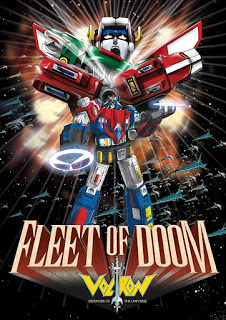 Voltron: Fleet of Doom, 1986, dir: Franklin Cofod
Voltron: Fleet of Doom, 1986, dir: Franklin CofodVoltron the series was, not uniquely in the American cartoon landscape, a mashing together of multiple and unrelated anime shows, in this case Beast King GoLion and Armored Fleet Dairugger XV. I confess a certain basic antipathy to it on those grounds: ripping up anime and mashing it awkwardly into the restrictions of a US kids' cartoon seems to me a basically obnoxious thing to do, even if similar acts of bastardisation did provide me with the odd fond childhood memory. At any rate, Voltron's twisted genesis would lead to one of the more bizarre instances of the practise in 1986, when its "creators" World Event Productions realised the only way they'd ever be able to get the two Voltrons together - that is, Dairugger and GoLion - was to invest in some brand new footage to tie up the loose ends of their usual cobbled-together nonsense. And thus was born Fleet of Doom, the TV special that might generously be described as the one and only Voltron movie.
It's possible to imagine how something not terrible might arise out of such a Frankensteinian act of creation, but, having seen a bit of the Voltron show(s) via the two episodes offered up on AnimeWork's release, it's hard to conceive of it happening under the Voltron name. There's the voice acting, for a start, which varies from blandly flat to nails-down-a-black-board excruciating. However, the finest of casts would have floundered over the lines they're expected to come out with. And writer Stan Oliver's script for Fleet of Doom surpasses even the expected levels of trite silliness you'd expect from a cheap kids' science-fiction show, by setting itself the rule that nothing can occur unless a character describes it in detail. As an example, there's a lengthy sequence in which the main protagonist for the purposes of the special, the thrillingly named Keith, is trapped in a dream reality, and drawing his pistol, he's shocked to see it turn into a snake, a shock he expresses by saying something along the lines of "What's this? My gun's turned into a snake." It's hard to imagine how any child old enough to string words together wouldn't feel patronised by dialogue that considers them too stupid to use their own eyes.
While this is ruinous, it's not as though the basic foundations are all that terrific. I don't mean Beast King GoLion and Armored Fleet Dairugger XV - the poached footage is generally fine, though more so in the case of the latter than the former - but it couldn't be more obvious that what we're watching is two separate episodes from two separate shows mangled together without a shred of grace. The Dairugger team get the worst of it; less than twelve hours later, I can't remember the most basic details of their plotline, if they had one at all. And indeed the Beast King GoLion scenes are inherently decent, with that aforementioned dream reality chucking up some weird and grotesque imagery, even if it's always deflated by Keith mouth-breathing something like "Boy howdy, that sure is weird and grotesque!" But it's self-evident that none of it fits together, and the attempts to make it do so range from the hilarious - one team having flashbacks to the japes they had with their companions before they found themselves in two different shows, er, universes - to the embarrassing. Distressingly, it's the big action climax that's the point of this mess that fares worst: the awesome battle that finds the Voltrons standing together to defeat a foe neither could handle alone consists solely of key frames without inbetweening - which is to say, it's a slide show. And not an especially well-drawn slideshow, either. Also, if we're being petty (and I guess I'm already well past that point!) I certainly got the sense that the film's big bad was within the capacities of just one Voltron.
You might ask what the point is in wasting so much vitriol on a TV special from a thirty-five year old cartoon, and obviously there isn't much of a one, except that it's fun to rant sometimes. The reviews on Amazon suggest that many people out there get a nostalgic kick from Fleet of Doom, and I guess that if non-critically recreating your childhood experiences is your bag, you might too. But for everyone else, Voltron: Fleet of Doom is pretty much garbage, managing to sabotage itself out of the sort of light-hearted pleasure you might expect from a well-loved cartoon property by being fundamentally incompetent in every way.
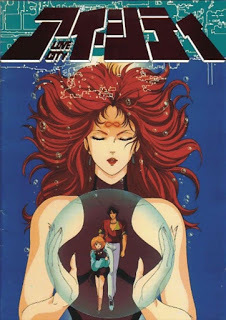 Ai City, 1986, dir: Kōichi Mashimo
Ai City, 1986, dir: Kōichi MashimoHad you wanted to pitch an eighties anime film to me, you couldn't have come up with anything much more persuasive than "It's what Kōichi Mashimo made directly before Dirty Pair: Project Eden, and kind of the same thing, only more so." Project Eden's glorious excesses of style, colour, character, music, and everything else it's possible to offer up in excess have steadily grown in my estimation to become one of my personal highlights from the decade; there's simply nothing else like it.
Except, of course, there is. Because a year prior, Mashimo had a trial run of just how far it was possible or sensible to push the envelope of anime stylisation, in the shape of one Ai City. And though he was developing an established manga property, there's the definite sense that he was working under fewer constraints: all that keeps Project Eden close to being a conventional narrative object is that it has to vaguely conform to what we expect from the Dirty Pair and their universe, whereas with Ai City, there's the impression from the beginning of a narrative being flung together at high velocity and according to no known rules. People switch sides at the drop of a hat, enormous concepts are hurled in with startling casualness, vital backstory is presented in what amounts to dream sequences, and the beginning, middle, and end are all focused around radically different circumstances and situations.
It helps somewhat that there are no particularly unfamiliar elements here, excepting perhaps the gloriously silly conceit whereby the battling psychics that make up most of the core cast have a digital readout on their foreheads displaying a number representing the level of their power at any given moment. But otherwise, if you've seen much anime, even if it's only a certain movie called Akira that would arrive soon after this, the essential ingredients won't surprise you. However, almost every detail and scene, taken on its own terms, is basically nuts, so those recognisable ideas soon become lifebelts in a very stormy sea. And all of this narrative excess is encapsulated in Mashimo's gloriously over the top fever dream of a style, with a colour palette that borders on the expressionistic and a constant vibe of animators experimenting for no real reason other than that they can. If it wasn't so exciting, it would be slightly obnoxious, and if we're being honest, by the midway point it's already a bit much. But even if a spot of reining in would have produced a traditionally better film, it's hard to be offended: there's always something thrilling or dizzying or weird around the next corner, and there are plenty of movies out there that resemble the conventional version of Ai City, but there's only one Ai City.
Whether that's an argument for you watching it depends on what you come to anime for in the first place. If ninety delirious minutes of neon-and-primary-coloured delirium with a story that's like watching Akira while on mushrooms sounds at all appealing, you absolutely need to track it down - and while it's only ever received an Italian DVD release, there's an excellent fansub on Youtube, so doing so isn't difficult. If, on the other hand, you're the kind of person who isn't terribly bothered about animation for its own sake and likes to spend more than five minutes of an hour-and-a-half-long movie feeling you know what's going on, it's safe to say you can skip this. But if that's the case, I feel a bit bad for you, because if you're willing to meet it halfway, Ai City is a hell of an experience.
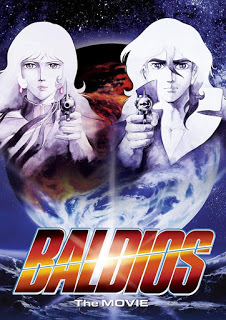 Space Warrior Baldios: The Movie, 1981, dir: Kentarō Haneda
Space Warrior Baldios: The Movie, 1981, dir: Kentarō HanedaIt's unfortunate that the element of Space Warrior Baldios that it takes its name from is also the only aspect it does tremendously badly. Baldios, you see, is the giant combining robot that plays almost no part in the movie, but was probably a meaningful component of the TV series that this is both a recap of and a conclusion to, what with the series being canned before it could reach its end. Anyway, Baldios the robot is crap, a clunky design indistinguishable from many a giant combining robot in many a giant robot show, even its transformation sequence is woefully uninspired, and the few scenes containing it are utterly generic takes on one of the most tapped-out subgenres in eighties anime.
I'd love to say that everything else about Space Warrior Baldios: The Movie is great, and I very nearly could, but we'd better just concede as well that it looks pretty crummy for the most part. I don't know how much this is new footage and how much it's combed together from the show, but rare are the moments that you feel you're watching something that belongs anywhere near a cinema. Thankfully, Baldios aside, the design work is solid, and unlike Baldios, the animation is never distractingly poor, it's just never much of an asset.
Phew! Now that's out of the way, we can get around to how excellent Space Warrior Baldios is - assuming you can get past the above, and the inevitable datedness of a movie that's almost four decades old. That's noticeable in the animation, and it's very noticeable indeed in the giant robot bits, but when Baldios is doing what it's great at - being an enormously bleak slice of science-fiction coupled with an equally bleak doomed romance - it's hard to fault. Its story begins straightforwardly enough, at least by early eighties SF anime standards, as our hero Marin gets on the wrong side of the fascistic Gattler, who's decided the solution to his planet's environmental catastrophe is to find a replacement, and announces this by having Marin's scientist father, who's on the verge of a far less militant solution, brutally assassinated. Marin takes his revenge on the killer, and in so doing incurs the wrath of the man's sister, Afrodia, even though you could cut the instantaneous sexual tension between them with a knife. Gattler sets off to invade a new world, which of course turns out to be Earth, Marin inadvertently gets there first and teams up with the locals, and Afrodia vigorously stamps down on every hint of her personality or morality in her determination to be a good officer for the invaders and ultimately to punish the man who took her brother's life, while ignoring the fact that he had a clear justification for doing so and that she desperately wants to jump his bones.
Bull all of that's only the first ten minutes or so, and to say more would ruin some ingenious and frequently gut-wrenching storytelling, along with an enormously satisfying and well-handled twist. I'm afraid this is one of those titles where you'll just have to take my word: if you can look past the dated, TV-level visuals and the occasional drifts into being a juvenile robot show, you'll find one of the best narratives in all of eighties science fiction, anime or no. That is, if you're watching the Japanese version; I haven't tried the heavily cut US adaptation, but I understand it to be much poorer and dumber. Stick with the original, though, and you'll be in for a rare treat, a bold and brutal fable that takes its superficially familiar ingredients to fascinating and unexpected places.
-oOo-
I feel like that might have been the strongest of these eighties posts, for all that Voltron was unutterable garbage and not even really anime in the traditional sense and certainly drags the selection down pretty hard. Ignore that blip, though, and we have three titles that come awfully close to being classics, and in that satisfying way of missing out through being too weird, experimental, or crushingly sombre to quite fit in to the usual categories.
As is probably obvious by now, I'm really starting to appreciate the eighties stuff, and so let's have a grateful nod in the direction of Discotek Media, who are responsible for both the Sea Prince and the Fire Child and Baldios releases, and in general have done wonders with bringing these older titles over to the West - even if they're atrocious at keeping them in print. But hey, nobody's perfect!
Next time, though, we'll be back in the right decade, and back to the usual randomosity...
[Other reviews in this series: By Date / By Title / By Rating]
September 21, 2020
Drowning in Nineties Anime, Pt. 80
Anyway, here's where we begin to find out, by way of Dragon Ball Z: Dead Zone, Dragon Ball Z: The World's Strongest, Dragon Ball Z: Tree of Might, and Dragon Ball Z: Lord Slug...
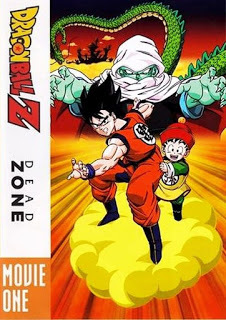 Dragon Ball Z: Dead Zone, 1989, dir: Daisuke Nishio
Dragon Ball Z: Dead Zone, 1989, dir: Daisuke NishioI went into this first Dragon Ball Z movie with certain negative preconceptions, and I'd say it bore them out to the tune of about eighty percent: I was expecting some of the clunkiest character designs in anime and lots of mindless fighting, and that was largely what I got. Thank goodness, then, for that other twenty percent, which was appealing enough to keep the experience on the right side of horrible.
Dragon Ball Z: Dead Zone feels made for fans of the series in a way none of the four Dragon Ball movies did. There's enough information given that you can basically follow everything that happens and appreciate broadly who everyone is without a recourse to Wikipedia, but you sure do need to be paying attention, which seems against the spirit of what's evidently supposed to be a brief burst of mindless entertainment. But then, that brevity is half the problem: Dead Zone doesn't even quite make it to forty-five minutes, and though there's hardly a lot of plot, what there is gets flung at the viewer so rapidly that it routinely loses all impact. There are ingredients here that certainly ought to have a bit of weight - a major villain uniting the dragon balls and using them for nefarious ends, what appears to be a battle for literal godhood, and a climax featuring the titular dead zone, which must be important for the film to be named after it - and yet most of them flit by in a couple of minutes, as the movie hurtles onto the next thing.
I'd recount the story in more detail, but it hardly seems worth the effort. There's that big bad, who's undermined from the off by having the preposterous name of Garlic Jr, and as part of his fiendish plan, he sort of accidentally kidnaps Goku's annoying son Gohan, and rather than do the sensible thing and chalk it up to bad luck, Goku feels the need to intercede, with the eventual aid of various other characters who just sort of blunder into the film. There's much fighting against Garlic Jr's three hench-monsters, all of whom look so crap that I can't bring myself to think about them, before a final showdown against Garlic Jr himself, who also looks quite crap. Seriously, am I the only person who hates how these characters look? They're like fan art of Lord of the Rings orcs drawn by a teenager who grew up reading nothing except Rob Liefeld comics.
But I said there was a twenty percent I had more time for, and I guess, in the interests of unbiased reviewing, I ought to finish with that. The designs may be trashy and the colours garish, but the backgrounds are mostly lovely, and I like Nishio enough as a director to concede that, outside of the rather listless fights, there are two or three really terrific sequences here, where he's evidently amusing himself by pushing things in directions that are outrageously trippy and / or apocalyptic. For example, Gohan redeems himself slightly by stopping the proceedings dead for a couple of minutes to deliver a drunken musical number that's the high point of the film, and later there's some hellish imagery that's legitimately interesting. And, again perhaps due to Nishio, who presumably knew how to get Dragon Ball right better than anyone, there's a breezy energy that keeps the whole business on the right side of watchable. That's faint praise, I know, but it's all I can stretch to; there's not a lot here for the first movie in such a mammoth series, and what there is could do with a more engaging style and a good fifteen minutes more of running time.
 Dragon Ball Z: The World's Strongest, 1990, dir: Daisuke Nishio
Dragon Ball Z: The World's Strongest, 1990, dir: Daisuke NishioIf, as I fear, these Dragon Ball Z movies are merely going to be a series of ever-escalating fight sequences, then The World's Strongest is how I'd like to see them go about it: this second film is a leap above Dead Zone in every way I can think of. It helps significantly that the running time has been stretched to just shy of an hour, allowing for some breathing room and what plot there is to develop at a reasonable pace. Watching it only emphasised the extent to which Dead Zone muted its impact by barrelling through what should have been major moments. Here, similar scenes unfold at a reasonable speed and so feel as though they actually have meaning. It's not like The World's Strongest hangs around or anything, but it has the space it needs to do the material justice.
Probably an even bigger deal, though, is that the villains are interesting, and not burdened with names that ought to be restricted to culinary ingredients. Here again, every aspect, from the voice acting to the designs to the manner in which they're introduced, is that bit more successful. And even their disposable underlings are much better, bringing quirks to the table that turn the fights from slapping matches into strategic puzzles. It's a little thing on the face of it, but it immediately gives the action - of which there's still an inordinate amount - a degree of tension and intrigue that was sorely lacking in Dead Zone, not to mention lending each confrontation a distinctive flavour.
And I realise I'm once again onto the third paragraph and haven't mentioned the story, but in honesty, it's the one element that's barely improved. There are villains, one of them's the still-living brain of a genius scientist who wants the body of the world's strongest fighter to really round out his CV, and after a mix-up in which they mistakenly abduct Master Roshi, they settle on Goku, who's more than up for a scrap. The only reason I'm trotting this out at all is so that you can hopefully see how a mad scientist brain in a jar and his only slightly less deranged assistant would make for fun antagonists. And that's perhaps the crucial point: The World's Strongest is fun. Even when it's dealing with events that theoretically should be quite serious, it keeps its tongue close to its cheek, and while I'm missing the out-and-out wackiness of the Dragon Ball films, this makes for an acceptable substitute, especially once it gets into its final third and the battle stretches to the sort of preposterously epic proportions only anime can deliver.
Oh, and the visuals are another major leap. The World's Strongest looks rather fine, all told, with routinely gorgeous backdrops, smooth animation, and, if I'm not mistaken, some tweaks to the design aesthetic that push it back fractionally in the softer, rounder direction of Dragon Ball. Or maybe I'm simply getting used to them? At any rate, there's nothing to complain about on the technical side. All in all, the sole significant problem - and problem, in this context, is an especially relative term, since I get that lots of people adore this series - is that the narrative is no more than an engine to keep the action flowing. Since that's what it apparently means to be a Dragon Ball Z movie, I guess we're back with what I said at the start: if this is the basic shape of what these things are going to be, The World's Strongest is close to the best version of that template I can imagine.
 Dragon Ball Z: Tree of Might, 1990, dir: Daisuke Nishio
Dragon Ball Z: Tree of Might, 1990, dir: Daisuke NishioIt's surely not possible that these movies are just going to keep improving, yet here we are on number three and it's possibly the best so far, not a small feat when The World's Strongest was already a standout. And okay, maybe Tree of Might doesn't precisely better it, though that argument could certainly be made, but it's every bit as good. What makes the difference, I think, is that it's the first Dragon Ball Z entry to crack an hour (and indeed, the first Dragon Ball film to full stop) and that extra running time, though it only amounts to a handful of minutes in the case of The World's Strongest, makes all the difference. It allows for a pacing that's almost leisurely in places, and thus builds up the conflict in a weighty, meaningful fashion, so that when the inevitable fighting comes, we're well aware of both the stakes and the rationale behind it. Moreover, that conflict is, in itself, a big leap up from what we've seen thus far, with a villain whose links to Goku and Goku's mysterious past make him feel that bit more significant, and a world-ending catastrophe that's unusual and interesting and genuinely dreadful enough that it seems to matter.
I won't spoil any of that - except to say that apocalypse by tree isn't something I've personally come across before - because it's probably best arrived at without much foreknowledge. And also because, truth be told, there's yet again not a great deal of plot here, and it still ultimately amounts to the usual "there's a super-strong baddie with a bunch of hench-folks and Goku and his friends have to fight them" template that I struggle to imagine a Dragon Ball Z movie breaking away from. Tree of Might is just built on better foundations than something like Dead Zone, and also a whole lot better made. These things have never looked shoddy, but this is still a leap forward; it's often spectacular, and in ways I wouldn't have anticipated Dragon Ball Z bothering with. In particular, the broad palette of intensely vibrant colours and the way certain scenes restrict that palette for effect is more sophisticated than anything we've encountered so far. And the animation isn't far behind. There are some stunning sequences, many of them involving the titular tree, and roots growing and twisting and thrashing in a destructive fashion that would make Akira proud. It really is a treat for the eyeballs, and cinema-worthy in a fashion that the franchise has only flirted with before.
Of course, great animation is mere eye candy without great direction, and while I've never had cause to fault Daisuke Nishio, this is a definite high point. The breathing room of the extra running time and the evidently lavish budget allow for a level of artistry beyond the deft, slick film-making he's previously exhibited, and there's room for things like actual themes that don't revolve around people punching each other: maybe there's nothing inherently profound about how he explores different aspects of nature throughout the film or keeps cutting back to locations and motifs to convey the wider impact of events, but it's fine storytelling all the same. Indeed, the biggest surprise here is that we have a Dragon Ball film that almost totally eschews the light-hearted adventure and comedy that were the bulk of what I'd been enjoying up to this point, and still kept me entranced for the space of an hour. Between this and The World's Strongest, I struggle to conceive of how the franchise can better itself going forward, or even keep up such a level of quality, but I'm beginning to dare hope I might be wrong.
 Dragon Ball Z: Lord Slug, 1991, dir: Mitsuo Hashimoto
Dragon Ball Z: Lord Slug, 1991, dir: Mitsuo HashimotoFor the first twenty minutes or so of Lord Slug, I continued to toy with the unlikely conviction that these things really might keep getting better. The opening is good enough to warrant such mad optimism, for numerous reasons. One is that, for the first time in a while, we get a scene that returns us to the goofiness which made the original Dragon Ball films so appealing, with a song and dance routine (of all things!) that's a hilariously joyful note to get things moving on. (That it later turns out to be in there for legitimate plot reasons spoils it only slightly.) Then the actual conflict kicks off, and its a belter, with some outstandingly economic storytelling hurling us into another crisis that feels suitably major and presenting an antagonist who's appropriately powerful and dangerous. Moreover, all this is wrapped up in some sterling animation: the aesthetic seems to have drifted back into a more traditional Dragon Ball mode, with everything becoming very soft and round and simple, and that scaling down not only makes Lord Slug easy on the eyes, it allows for some striking sequences. In particular, the inevitable destruction really looks the part, and helps to sell the notion that we're witnessing truly world-threatening events.
The threat this time comes from the titular Lord Slug, another alien invader, but one who wastes all of about three minutes in subjugating the Earth, and manages to kill a couple of his own underlings in the process, not to mention gathering the dragon balls and restoring his youth, so there's not much doubt he means business. Nevertheless, it's a disappointment when the setup has to give way to the traditional Dragon Ball Z third act, if we can call something that takes up fifty percent of the film a third act. There's lots and lots of fighting, and it's pretty good fighting, with enough wrinkles to avoid the feeling that super-powerful people are taking it in turns to shoot super-powers at each other, and the ultimate battle - spoiler warning for people who can't predict a Dragon Ball Z plot! - between Goku and Lord Slug is suitably epic, so there's no arguing the movie doesn't do a perfectly acceptable job of what it sets out to accomplish. It's only that what its aiming for has been done three times already in three preceding films, and we're at the point where I for one am ready for something even slightly different.
Moreover, at around fifty minutes, Lord Slug bucks the steady trend by which these films were getting longer with each entry, and that doesn't do it any favours either; when epicness is such a crucial component of their makeup, that extra few minutes can make all the difference, as Tree of Might amply proved. This seems like a step back in the Dead Zone direction, even if in every other meaningful way it's an improvement on that wonky beginning. And here it's worth a nod to director Mitsuo Hashimoto, who picks up the reins so smoothly from Daisuke Nishio that I honestly wouldn't have noticed the change had I not known in advance. There's no question that he delivers a thoroughly solid Dragon Ball Z movie; it's just a shame its beginning offers more than it can deliver, and that the two previous entries showed that the franchise is capable of more than solidness.
-oOo-
So that went better than I expected - which is weird, in a way, because it also went more or less exactly the way I expected. Probably it helps to go at these things with your eyes open, and for me, I'm sure it helps too that I'm enough of an animation nerd to enjoy well-made films even when they're very much not to my personal tastes. I mean, I do sort of get the appeal here - except for those character designs, which I'm just about at the point of finding tolerable - but I also don't understand why the fandom and the creators couldn't get together and arrange for a bit of variety. Like, what if every fourth Dragon Ball Z film had an actual story? Would that be such a disaster?
Oh well. Given that I watched these four in a box set and two of the four movies were pretty great and only one was actively poor, I at least feel I got my money's worth. And the knowledge that there are another nine entries to go? I guess I'll manage somehow...
[Other reviews in this series: By Date / By Title / By Rating]
September 14, 2020
Drowning in Nineties Anime, Pt. 79
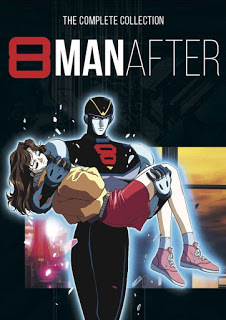 8 Man After, 1992, dir: Yoriyasu Kogawa
8 Man After, 1992, dir: Yoriyasu KogawaIn fairness to 8 Man After, its most damning flaw isn't at all its fault. The reason it comes across as a half-hearted Robocop rip-off isn't that it's half-heartedly ripping off Robocop. The truth is that the 8 Man franchise got to the whole law-enforcer-brought-back-as-a-cyborg-to-fight-crime subgenre some twenty years and change before Paul Verhoeven's iconic movie; indeed, the title refers to the fact that the show's hero constitutes an entire eighth precinct all by himself. None of this, it should be noted, changes the fact that 8 Man After seems like a half-hearted Robocop rip-off, it just makes me feel worse for pointing it out.
The OVA is essentially standalone, though it harks back to the show in numerous ways. Not the least of these is that it carries over the female lead, Sachiko, who's still faintly sad and bitter about how she was abandoned by the original protagonist once she discovered he was a shape-shifting robot with nifty superspeed powers. However, our actual hero this time around is embittered detective Hazama, who encounters Sachiko as he's pursuing the trail of some stolen cyborgisation technology on behalf of its creator, who in turn fears that it's behind the recent rash of thugs with horribly violent mechanical attachments and a tendency to fly into drug-fuelled rages.
The first episode lays this all out rather well, and it's odd in a way that - spoiler, I guess! - the moment Hazama becomes the new 8 Man, the proceedings begin to fall apart. The problem is partly that, with the vaguely intriguing setup out of the way, there's nothing especially interesting to hang onto; not the characters, not the animation, not the plot beats, and not the action, all of which are decidedly rote. But couple that with the predictability of an OVA that simply has nothing going on you won't have seen done better elsewhere, both within and without of anime, and its tough to maintain any enthusiasm.
Ultimately, 8 Man After feels like what I suspect it was: an opportunistic attempt to revive a classic franchise that had suddenly become current again, or at least could be made so with some hefty alterations. The logic is plain to see: make 8 Man all dark and gritty and immediately you have something that fits comfortably alongside the likes of Robocop or the many anime that were getting mileage from the concepts of killer cyborgs and runaway robotics. And that logic might even have been sound were the execution not so lacklustre and - let's face it! - the character design not so goofy and ill-fitted for that sort of narrative. There are glimpses of a more successful version, one more noirish that sticks with the detective elements, maybe, and that finds ways to incorporate the leftover sixties silliness rather that plastering over it with copious bloodshed. Nevertheless, that's not what 8 Man After ends up providing, and what's here is functional enough but hugely uninspired.
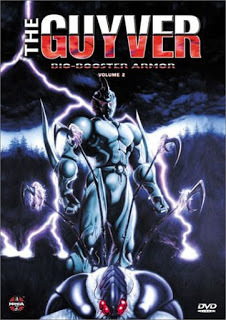 The Guyver: Bio-Booster Armor, Volume 2, 1992, dir's: Masahiro Ōtani, Naoto Hashimoto
The Guyver: Bio-Booster Armor, Volume 2, 1992, dir's: Masahiro Ōtani, Naoto HashimotoThe first three episodes of the second volume of the Guyver OVA look like hot garbage. I realise that isn't a terribly technical term, but it's absolute the correct one: this is some shockingly ugly animation right here. I mean, literally ugly in the sense that it's unpleasant to watch, what with the persistent impression that no-one on the staff quite knew how to draw things like faces or bodies, but also ugly in the more routine ways that bad animation is bad: there's nowhere near enough inbetweening, leading to stuttering visuals that provide only the crudest sense of motion, and that motion often looks as though it was crafted by artists who were going off their best guesses as to how people and objects ought to move. I remember complimenting the first volume of The Guyver: Bio-Booster Armor for the extent to which, even when there were evident dips in the budget, they never marred the overall experience. Here, there's no end of marring: the impression is that everyone involved discovered that their funding had been cut in half the day before shooting began and figured they might as well give up rather than embarrass themselves by trying. Though, while nobody's up to anything noticeably impressive, I'm inclined to put the bulk of the blame on director Masahiro Ōtani, since there's the definite sense that the problems started at the top and filtered down.
But the main reason I lean toward blaming Ōtani is that, the minute his replacement Naoto Hashimoto steps up to bat with the fourth episode, things improve so dramatically that it practically gives you whiplash. Until that point, The Guyver: Bio-Booster Armor hasn't exactly been a chore, except of course for how ghastly and primitive it all looks. The content is still strong, and you can't make a show about organic armoured suits fighting hideous monsters and not deliver the occasional cool moment. It feels cheap and frustrating after the consistent goodness of the first volume, but it's not what you'd call awful. However, Hashimoto's arrival is a breath of fresh air in every conceivable way. What clued me in to the change of directors was partly how much the character designs alter, entirely for the better, but mostly that, out of nowhere, interesting things begin happening on the level of animation. Everything gets a bit stretchier and squashier and more fluid, a touch distorted even, in a manner that's perfectly fitted to the weirdness of the material. And once you've spotted that, it's hard to miss how suddenly shot choices begin to make sense, how compositions have got more ingenious - how much the medium is suddenly an asset to be exploited rather than a burden.
And here we are on the last paragraph and I've said nothing about the story of this second volume. Perhaps that's down to the fact that it left me with a slightly bitter taste in my mouth. While this back half of the OVA wraps up some of the threads from the first part and most of the new ones it introduces, it stops a long way short of a conclusive ending; actually, it's less satisfying on that front than part one, which was quite open about the fact that there was plenty more story to come. Heck, it doesn't even manage to deal with the major new villain it introduces or its own most significant plot twist, leaving the definite sense that there was more planned that for whatever reason (personally I blame Ōtani!) never came to pass. The Guyver: Bio-Booster Armor being what it is - i.e. a whole bunch of nifty, horribly violent fights - that's hardly crippling, and perhaps I was naive to expect any different from an adaptation of a gigantically long-running manga. Still, that and the general shoddiness of three of its episodes makes this closing volume a lot harder to be enthusiastic about than the first.
 Starship Girl Yamamoto Yohko, 1996, dir: Akiyuki Shinbo
Starship Girl Yamamoto Yohko, 1996, dir: Akiyuki ShinboObviously, only hardened anime nerds care much about who released a given title, let alone the often complex histories of those distributors. Nevertheless, sometimes it's instructive to understand what a publisher was about, and for me that's definitely the case with The Right Stuf International. The company still exists, owning the excellent Nozomi among other branches, and even still releases vintage titles, but in its original incarnation it was a weird creature indeed. Mostly, Right Stuf focused on series, and when it bothered itself with shorter standalone titles, they were almost invariably hentai, with only a tiny handful of exceptions. And when I say "tiny handful", we're talking half a dozen at most. Magic User's Club, Assemble Insert, and Aria were in there, all of which I've had positive things to say about here, and so was our present subject, Starship Girl Yamamoto Yohko.
The point that I'm long-windedly leading up to is that Right Stuf may not have released much in the way of shorter titles, but what they did put out was pretty great, and also pretty unconventional. Of the three titles we've already covered here, only Aria was likely to be much of a commercial success, the other two are far too odd and distinctive. And that's certainly the niche Starship Girl Yamamoto Yohko falls into.
That's not altogether apparent in the first episode, which is the weakest of the six (these actually form two OVAs of three parts each; the second arrived a year after.) The premise is as ingenious as it is nonsensical: in the far-distant future, all trade conflicts are settled through the medium of small-scale, non-lethal space battles, and the Earth team has hit on the unorthodox tactic of recruiting its pilots from the twentieth century Japanese school system, presumably having seen enough of those ancient historical documents known as "anime" to appreciate that nobody pilots death machines better than teenage Japanese girls. Anyway, the show never tries to grapple with this absurd setup, though the trade dispute element will prove more central. But as far as teenage pilots go, all we need to know is that the understaffed Earth team aren't faring well against their nemeses the Red Snappers, and that that's all set to change with the the arrival of their somewhat obnoxious new recruit Yohko Yamamoto.
If Starship Girl Yamamoto Yohko has problems, they figure highly in this introductory episode: the setup is ridiculous and our protagonist isn't very likeable, at least not until we've had a chance to warm to her. But both those issues are a good deal less noticeable by the second episode, and after that they pretty much dissolve. Equally, there's not much in the way of an arc plot, but it's impossible to miss when the standalone stories are as excellent as these, and when everything is delivered with such panache. It's tempting to lay Starship Girl Yamamoto Yohko's success in the lap of Akiyuki Shinbo, knowing he'd go on to make the masterful Puella Magi Madoka Magica and that, even without that, he'd still have a heck of a CV. And throwing credit in Shinbo's direction definitely isn't unfair: by the last couple of episodes, the show is operating at quite a dazzling level of raw style, to a point where it's hard to remember you're supposed to be watching a dumb sci-fi comedy show; episode five plays out like a pop-art version of Frankenstein and the last part reminded me of nothing more than Revolutionary Girl Utena. But really, after that slightly shaky start, there's no element that isn't a triumph, and certainly nobody on the animation team is failing to carry their weight.
I guess that, stripped to its essentials, and perhaps ignoring quite how weird its setup is, Starship Girl Yamamoto Yohko is an awful lot like an awful lot of other shorter anime titles. But what sets it apart, and what presumably made it seem like a neat fit for Right Stuf's tiny library of quirky, brilliant releases, is all in the execution. What we get is effectively six marvellous short tales delivered with a ton of style, wit, and originality, and all in all one of the finer OVAs I've come across.
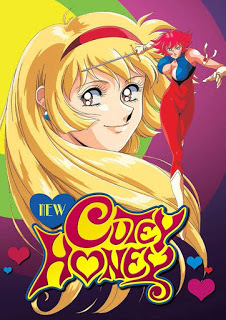 New Cutey Honey, 1994, dir: Yasuchika Nagaoka
New Cutey Honey, 1994, dir: Yasuchika NagaokaI'm inclined to say that I don't get the appeal of Go Nagai, but it's not like it's hard to get: he wrote comics full of crazy violence and gratuitous nudity, it ain't rocket science. So maybe what I mean is that I don't get how Nagai seems to have such an enduring reputation when that - along maybe with a certain entertaining interconnectedness between his various franchises and an unrepentant desire to shock - seems to be about all he has going for him. That's not to say I've hated every adaptation of his work; I kind of adored Devilman for its freakish excesses, and Kekko Kamen amused me even while I wouldn't pretend for a second that it was any good. Granted, Violence Jack I despised with every cell of my body, but that still adds up to a reasonable track record. It's just not the sort of track record that justifies any sort of status as a legend of the industry, that's all.
New Cutey Honey wasn't the show to change my mind, but perhaps it was the one that finally made me appreciate why there's still so much fondness for Nagai when what he was doing was mostly crass and dumb. New Cutey Honey is crass and dumb, but it also flirts with genius, and often at the same time. The concept is this: in a dark futuristic world ruled by gangsters, monsters, and monsters who are also gangsters, Cosplay City cries out for a saviour, and she arrives in the shape of Cutey Honey, an android with the ability to assume any form, as long as said form is that of an attractive woman with implausibly large breasts. (Granted there are exceptions, but it's a fair rule of thumb.) This being Go Nagai, Honey transforms by shouting "Cutey flash!", at which point her clothes dissolve into shreds, she spends a couple of seconds being very naked indeed, and then her new costumed identity kind of wraps itself around her.
And for all the flaws of New Cutey Honey, which certainly extend well beyond the fact that it frequently feels like nothing except an excuse to show off her ample bosom, Honey herself is rather wonderful as character concepts go. She's tough yet kind, charming and witty yet often oddly innocent, and generally feels more like a living, breathing person than you could possibly hope for when the entire concept is that she's an android assuming identities at will. Maybe the credit for that ought to go to actress Michiko Neya, maybe a little of it should be thrown in Nagai's direction, and certainly it helps that the routinely splendid animation and design work sells the fact that all these diverse incarnations are one and the same person. At any rate, however many times you find yourself looking at Honey's honey flash, she somehow never seems to be reduced to the oversimplified male fantasy that you'd assume would be almost inevitable given a concept such as this.
Sad to say, everything that's going on around Honey herself is never quite so strong. That this is two OVAs, one with a loose arc plot and the second with various baddies of the week, doesn't help; there are no especially weak episodes, but it also never particularly goes anywhere, and the supporting cast and villains are entertaining caricatures rather than well-developed characters. For that matter, even within a brief eight episodes, there are details that are impossible to square with each other, and in general it feels as though the show is making itself up as it goes along and switching directions on a whim. Yet though such problems seem quite significant when you're trying to talk about it in retrospect, they're less of a bother in the moment; while you're watching, New Cutey Honey shares the giddy, poppy charm of its surprisingly complex heroine, and manages to be quite the unexpected delight.
-oOo-
Starship Girl Yamamoto Yohko and New Cutey Honey are the obvious standouts here, but there's nothing that was altogether without merit. Reviewing The Guyver: Bio-Booster Armor in two parts just because that was how Manga happened to release it back in the day was perhaps a bit unfair, and certainly did it no favours; three weaker episodes out of twelve is less damning than three out of six, after all, and I'd certainly recommend it overall, despite the dip in quality. As for 8 Man After, I'm torn between thinking I was a bit harsh on it and thinking that actually no I wasn't, because it really was fairly boring. At any rate, it wasn't awful, and getting through one of these posts with no awful titles always feels like a win.
[Other reviews in this series: By Date / By Title / By Rating]
September 7, 2020
Drowning in Nineties Anime, Pt. 78
Not so long ago, I was looking at El-Hazard, a franchise that failed to stand the test of time or even survive the nineties, and here, by way of contrast, we have one that's proved totally indefatigable, with its most recent incarnation appearing only last year. There's a truly staggering amount of Saint Seiya out there, but fortunately for our purposes, all we need concern ourselves with are the four short films released in a mad burst between 1987 and 1989. Which leaves us with: Saint Seiya: Evil Goddess Eris, Saint Seiya: The Heated Battle of the Gods, Saint Seiya: Legend of Crimson Youth, and Saint Seiya: Warriors of the Final Holy Battle...
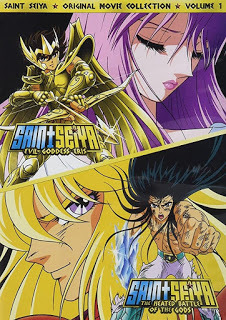 Saint Seiya: Evil Goddess Eris, 1987, dir: Kōzō Morishita
Saint Seiya: Evil Goddess Eris, 1987, dir: Kōzō MorishitaThere's always the worry with coming to a major franchise via its spin-off films that you'll end up adrift in a sea of ongoing plot and pre-established characters, or at the least that you'll miss out on some of the more significant subtleties. But the first Saint Seiya movie, Evil Goddess Eris, puts those concerns to rest in no time at all. First up, it's kind enough to provide a potted history of its concept, in which the reincarnated goddess Athena is protected by five young men with various powers granted to them by mystical garments known as Cloths. And second, it really hasn't any plot.
I mean that literally, though perhaps not wholly as a criticism. What Evil Goddess Eris has to offer is a setup, or perhaps just an excuse for an almighty scrap. It goes something like this: a meteor falls from the sky, but it's actually the golden apple of Greek mythology and possessed by Eris, goddess of strife, who decides, not unreasonably, that she'd much rather reincarnate herself using Athena's life-force than spend the rest of her days as an apple. And since it's a safe bet that Athena's gang of super-powered guardians might not be down with this plan, she brings along some muscle, in the form of the Ghost Saints, who are ... well, you know, the ghosts of former Saints.
That sounds quite busy, doesn't it? But honestly, it's whooshed through in the space of five minutes, and from there on, it's all about the scrapping. The good Saints and bad Saints even do that thing where they pair off one on one, so that what we get isn't one big action sequence but a string of smaller ones that the film bounces between. If it wasn't for the gloss of Greek mythology, it would be indistinguishable from a million similar shows. Then again, when you've only forty-five minutes to fill and you're eager to keep things friendly for new viewers, is that such a bad thing?
Well, yes and no. Given how much plot I've seen anime movies burn through in this kind of short running time, there's certainly a lack of ambition to Evil Goddess Eris. However, what saved it for me - and I must stress, might not save it for you - is that it looks pretty fine. Not so much the character animation maybe, I never quite warmed to the designs and even then it's mid-tier work, but the backgrounds are gorgeous, digging deep into the mythology that the narrative is barely skirting around. The artists conclude, quite rightly, that if you chuck in enough crumbling columns, you'll end up with the tone of awesome ancientness that this material needs to come across as the epic battle of good versus evil the writers have barely bothered to sketch in. And when those columns are routinely being blown apart by some sterling effects work, or are crumbling in lavishly detailed scenes of destruction, it's hard to be bothered by how conspicuously absent the story is.
Then again, however prettily you dress up forty-five minutes of fight scenes, the result is still going to be forty-five minutes of fight scenes, and it's not like they're even particularly great fight scenes; there's a jot more sophistication here that the usual special-move tennis, but not much. So while Evil Goddess Eris was an enjoyable enough introduction to the franchise, and a perfectly passable way to spend three quarters of an hour, I do hope we get something a bit more substantial next time.
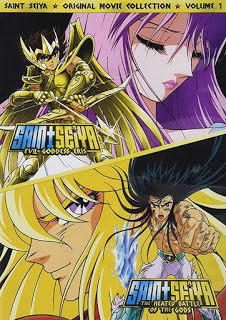 Saint Seiya: The Heated Battle of the Gods, 1988, dir: Shigeyasu Yamauchi
Saint Seiya: The Heated Battle of the Gods, 1988, dir: Shigeyasu YamauchiIt seems a mere sentence ago that I was saying how I'd like the second Saint Seiya film to have more meat on its bones than the first, so colour me disappointed that The Heated Battle of the Gods is to all intents and purposes Evil Goddess Eris with the serial numbers filed off. And as we reach the halfway point in my Saint Seiya marathon, I find myself wondering, with a degree of trepidation, whether this was simply the formula the series followed and which the movies were obliged to follow in turn. Is it too much to hope for a Saint Seiya episode that isn't one lengthy fight against imaginatively powered foes and a big boss who has evil intentions for Athena's earthly avatar that effectively mean she does next to nothing for the better part of forty-five minutes?
And yes, it's genuinely that similar. Really, the only meaningful change is that of setting, which actually manages to be enough to ensure that The Heated Battle of the Gods is fractionally more interesting than its predecessor. Eris wasn't a memorable villain and the Greek-styled locations, pretty though they were, never gelled into a coherent place the way the sequel's Asgard does. It's both beautifully painted and intelligently designed and presented, so that by the end we have a real sense of the geography, which in turn feeds back in some interesting thematic ways. It's a fine bit of place as character, basically, which is useful given that the flesh and blood characters (and indeed, the character animation) are considerably less striking. In general, the visuals are perhaps a fraction better this time around, and the effects work continues to impress - the opening scene, set against a backdrop of the northern lights, is especially ingenious - but then it's surely a good job given how much of the heavy lifting they're required to do.
That aside, mention is due to Seiji Yokoyama's splendid score. He was around for Evil Goddess Eris, too, but I don't recall anything standing out the way the main themes here do. The one that really stuck with me sounds more French than Norse, but it's hugely effective, and its not as though this series seems terribly concerned with adhering to anything approximating world mythology. Which is a shame, incidentally, because, aside from greater depth and an actual plot, that's one thing that could have nudged The Heated Battle of the Gods from good to great: as engaging as the Norse setting is, it feels that the film flirts with it rather than digging into it and taking advantage of its larger-than-life inhabitants. Nevertheless, make no mistake, this is a good film for much the same reasons the first was, and assuming you're open to the basic notion of watching colourful characters fight for three quarters of an hour. If this genuinely turns out to be all Saint Seiya has to provide, I guess we ought to be glad it's done well. Still, though, maybe just maybe we could have a spot of actual story next time around?
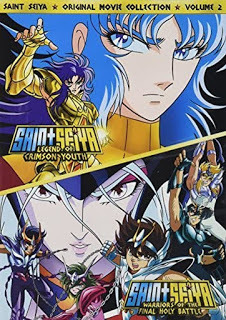 Saint Seiya: Legend of Crimson Youth, 1988, dir: Shigeyasu Yamauchi
Saint Seiya: Legend of Crimson Youth, 1988, dir: Shigeyasu YamauchiFool me once, Saint Seiya, and that's on you. Fool me twice and ... no actually, that's still on you. It wasn't unreasonable to suppose that, with an extra thirty minutes of running time pushing it up to somewhere near a full-blown, non-anime feature length, Legend of Crimson Youth would be the first of these things to have a bit of proper content. I mean, you can't spin out a fight scene for seventy-fives minutes, now, can you?
"Ha!" laughs the Saint Seiya franchise, "I can and I will!" Because not only does Legend of Crimson Youth not have a plot, it has precisely the same non-plot as both its predecessors: a divine baddie turns up with a bunch of lackeys and incapacitates Athena / Saori, who then has to be rescued via a series of one-on-one fights that our heroes pretty much lose, but somehow actually win, often by apparently just deciding they're going to, so that they can get around to dealing with the big bad. To say the formula is starting to feel tired is to downplay how it's less a formula, more a cut and paste job. And Legend of Crimson Youth makes this that bit more annoying by actually offering up a few ideas that would have made for a solid story with, like, themes and stuff. Our antagonist for this one is Athena's brother, which immediately sets up tensions that make him a more resonant threat, and his mission to destroy the world on divine orders is both larger scale and more personal than what we've seen before: for the first time, the notion that we're dealing with gods walking among men actually seems significant rather than an excuse for amusing superpowers to be flung around.
None of this goes anywhere - it's actually quite amazing how little it goes anywhere! - but it does, if nothing else, provide a fraction more edge to the goings-on, and an excuse for some fine imagery: this time around, poor Athena has literally been cast down into the underworld, and if there's one thing Saint Seiya is good at, it's finding cool ways to visualise the settings of classical literature. In general, Legend of Crimson Youth is a marked visual step up from its predecessors, neither of which were remotely slouching. But here we get everything that was working previously - that is, the gorgeous backgrounds and sterling effects work - and the one relative weakness, the spotty character animation, is finally raised to the level everything else is operating at. It's a splendid-looking film, even by the standards of a series that has consistently set the bar high. And if series regular Yokoyama's score isn't up to anything as interesting as in The Heated Battle of the Gods, it's still a top tier effort.
So where does that leave us? On the one hand, you'd think Legend of Crimson Youth would be the best Saint Seiya movie yet, on the grounds that it's both the longest and the prettiest, and since being pretty is the sole level on which these things are really succeeding, that's got to count for something. However, the extra half hour doesn't benefit proceedings much - weirdly, this feels exactly as long as the last two - and it's the least new-viewer friendly, in that it's evidently tying in directly to the show in ways that frequently left me conscious I was missing a certain amount of significance. As such, I don't know that I can recommend it any more or any less: seventy-five minutes of neat fights and dodgy mythology dressed up in mostly splendid animation isn't something to turn your nose up at, but it's clear this franchise could do so much more if it would only step away from its formula even marginally.
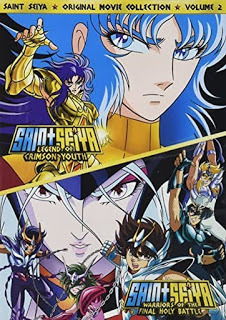 Saint Seiya: Warriors of the Final Holy Battle, 1989, dir: Masayuki Akehi
Saint Seiya: Warriors of the Final Holy Battle, 1989, dir: Masayuki AkehiFour films in and I've officially run out of interesting ways to say that these things are all basically identical. Then again, perhaps that's for the best, since the creators also seem to have run out of any will to try and hide the fact. Warriors of the Final Holy Battle couldn't hew much more closely to the formula that's become so overly familiar by now if it tried. Actually, I'm not certain it isn't trying; surely you can't keep making the same movie over and over again without some sort of conscious effort?
Anyway, if nothing else, this makes for an easy review: Warriors of the Final Holy Battle is Evil Goddess Eris and its two successors, only this time the main antagonist is Lucifer and his henchmen are fallen angels. Not that you'd know the difference if the characters themselves didn't make a point of stressing it, and it's quite the accomplishment to make a figure with the sheer mythic presence of Lucifer seem so thoroughly generic. He doesn't remotely look like any traditional representation, and short of one mention of Jesus, there's almost nothing here that grounds him in Christian mythology. He's another bad guy, leading another bunch of other bad guys, and the fight plays out much as the last three have: it looks as though the Saints are guaranteed to lose until, for no particular reason, they don't. Indeed, with no need to concentrate on a plot that wasn't there, I couldn't help noticing how even minor details are precisely the same in every one of these. There's the character who reliably gets saved by his older brother, and always seems surprised, when you'd think he'd be counting on it by now; there's the way the big boss is invariably at the top of an elevated structure the Saints have to battle up. Why anyone imagined that changing this formula in the slightest would be so ruinous that it had to be avoided at all costs, I can't say, but that seems to have been the prime motivation in the making of Warriors of the Final Holy Battle: stick to what works, even when sticking so damn hard has already robbed it of all impact.
However, there is one change, and it's not for the good: it may to some extent have been to do with my interest slipping, but I definitely got the impression the animation was a notch down from the high standards I'd grown used to. There are a few flat-out bad shots, the characters are back to looking decidedly wonky, and the standout moments that might distract from all that are seldom to be found. How much of this is director Akehi's fault I can't say, but there's little sense of directorial presence. Here as elsewhere, the word that springs most to mind is "perfunctory".
I suppose that, if you were to watch Warriors of the Final Holy Battle in isolation - which would be a weird thing to do, but someone conceivably might - it would be a tolerable waste of forty-five minutes. Nothing about it could legitimately be described as bad, though lots of it is decidedly lacklustre. But the truth is that you're likely to come at this fourth film on the back of the preceding three, as I have, and viewed in that context, it's without doubt the weakest, most disposable entry in a series that apparently had all of one idea and was more than willing to flog it to death.
-oOo-
Wait, hold on, this isn't even a nineties franchise, is it? I didn't remotely have to put myself through this nonsense! Oh well. I don't altogether regret my time with Saint Seiya, though I certainly won't be seeking out any more of it. Still, all these movies were decent enough, and if you didn't watch all four in close succession as I did, you might even call them pretty good. I mean, I wouldn't, but you might. If you're not in the business of obsessively reviewing every bit of anime released in or around the nineties, I'd hesitantly recommend sampling one of them, and I'd make that one The Heated Battle of the Gods. Though I suppose an advantage of them all being functionally identical is that you can't go too wrong, whatever you pick!
Next time around: hopefully four releases that I can tell the difference between...
[Other reviews in this series: By Date / By Title / By Rating]
August 31, 2020
Drowning in Nineties Anime, Pt. 77
That aside, the unplanned Lupin and Black Jack marathons trundle on, and we've one of those random standalone titles that seem to be getting harder and harder to find, which gives us The Guyver: Bio-Booster Armor, Volume 1, Black Jack: Parasite, Lupin the Third: Voyage to Danger, and Sorcerer on the Rocks...
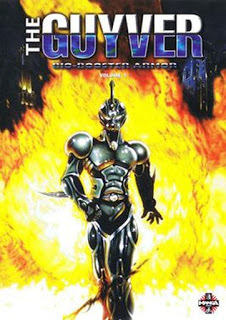 The Guyver: Bio-Booster Armor, Volume 1, 1989, dir: Koichi Ishiguro
The Guyver: Bio-Booster Armor, Volume 1, 1989, dir: Koichi IshiguroI mean this as a compliment, though maybe it won't sound like one: the first volume of The Guyver: Bio-Booster Armor does a terrific job of telling three hours' worth of story over the course of three hours. Okay, yes, that does sound like faint praise, but let's face it, many an anime from the period failed to do that, and it's all the less likely with such an action-heavy title as this, where it's easy for six episodes to devolve into six fights broken up with sufficient setup to clarify whatever plot there is and keep the budget at a manageable level. Which, now that I describe it, is exactly what this does, so I suppose what I'm really complimenting it on is doing so in a fashion that works. Within the episodic structure dictated by its material, it nevertheless succeeds in offering features like rising action, meaningful arcs, and late-game plot twists in such a way that we feel we're getting a single coherent tale.
That tale follows teenager Sho, who, along with his best friend Tetsurou, happens to stumble into a very messy set of circumstances involving the evil Chronos Corporation, who've misplaced a suitcase containing three wearable bioweapons - that's to say, Guyvers - and are busy trying to find them using their other, more readily available bioweapons, the monstrous Zoanoids, because if there's one thing Chronos is all about, it's bioweapons. And wouldn't you know it, who should stumble on said suitcase and get himself bonded with a Guyver unit than young Sho, who soon finds that he'll be spending his day - and indeed, most of the days following - punching gross monsters in the face until they explode.
To return to my original point, you can very much see how that might go if it didn't go well; we've probably all come across the odd anime that closely resembles watching your mate play through a series of video game boss fights. And in a sense, that's what we're here for. At heart, The Guyver is a much bloodier version of an older form that's been kicking around in Japanese culture for decades; what we have is absolutely a Super Sentai show in the vein of Might Morphin Power Rangers and its progenitors, and nobody goes to those in search of narrative sophistication, do they? They go for people in suits punching out monsters.
But what The Guyver: Bio-Booster Armor brings to that formula is just enough story, and just enough twistiness and characterisation, to provide a meaningful backbone to the fights and to ensure they escalate nicely, keeping a genuine sense of danger right through to the end. And, again at the risk of damning with faint praise by comparing with less successful shows, it's a bonus that, though there are definite fluctuations, the designs and technical values feel broadly of a piece across all six episodes. They're never outright bad, they're rarely amazing, but they're consistent. And what all this consistency and competence does is let us enjoy the coolness of a teenager in a terrifying sentient suit made of alien flesh getting into startlingly violent fights with a carnival of imaginatively designed monsters without feeling like the whole business is hopelessly dumb and empty.
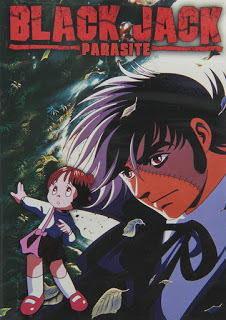 Black Jack: Parasite, 1999, dir: Osamu Dezaki
Black Jack: Parasite, 1999, dir: Osamu DezakiHere we are with the eighth episode of the Black Jack OVA series, released on the cusp of the end of the nineties, and for the first time, I find myself incapable of reviewing an Osamu Dezaki-directed title with either open hostility or, as has been getting more and more common, tentative praise. No, the fact is that his work here is a top-tier piece of visual storytelling, taking an interesting notion and using the medium of animation to bring to the surface its grace notes and reveal its hidden depths. Heck, I can't even grumble about his grab bag of tricks and stylistic excesses, because here they're deployed to perfection, discreetly enough to be an interesting surprise and so well-timed that they always achieve precisely the effect Dezaki was evidently aiming for. At one point, for instance, he does that thing he was so fond of whereby the animation stops on a painted still, and it's both such a compelling image and so intuitively placed that it's a little bit heart-stopping.
To all of that lavish praise, I'd add that I'm really beginning to fall in love with these Black Jack OVAs, and it's incredibly galling that they're so tough to find. It takes a bit of getting your head around their appeal, magical realist medical thrillers not being a particularly busy sub-genre, but when they work, they really work, crafting something outstandingly weird and exciting that hews just close enough to reality to not feel utterly silly, while still going to some distinctly odd places. Here, in the episode U.S. Manga Corps released under the title of Parasite, for example, we have a schoolboy apparently becoming infected by the massive, possibly sentient tree that protects an isolated village, but also is the favoured local suicide spot. It's the sort of setup where you can see the broad outlines almost from the get-go, yet the specific turns it takes, along with the profoundly bizarre imagery it presents, add up to something legitimately unique. And Dezaki finds a perfect tone, balancing the material between wonder and horror, so that we're never certain which way it will tip. One minute it feels like a Miyazaki homage, the next it's closer to David Cronenberg, and frankly, if you've never been curious as to how a Miyazaki / Cronenberg collaboration might turn out, you're probably reading the wrong reviewer.
What's perhaps most striking for such a relatively short film, though, is that it manages to sneak in some genuinely strong characterisation. The schoolboy and his brother are pretty boring, it has to be said, and Black Jack is essentially a cipher, but this episode does great things with his assistant Pinoko - though granted they wouldn't make a lot of sense if you weren't familiar with her history. At any rate, it's nice to see her being put to meaningful use. The real star, however, is one-off character Armando, who could easily have been nothing but a source of exposition and instead gets a heartrending arc of his own. He's surely my favourite thing here - though the opening, a gorgeous combination of music and imagery that Dezaki choreographs to perfection, comes a close second. And actually, there's that phenomenal surgery sequence too, which brings all the latent body horror bubbling into full view. Oh, and the closing theme is marvellous. Really, Black Jack: Parasite is so full of good parts that I could sing its praises for twice as many words as I've used here.
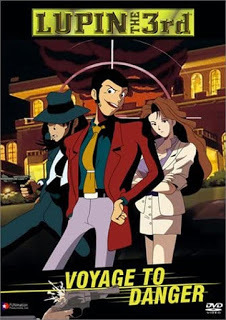 Lupin the Third: Voyage to Danger, 1993, dir: Masaaki Ôsumi
Lupin the Third: Voyage to Danger, 1993, dir: Masaaki ÔsumiWith so many Lupin stories out there, it's a sure thing that a sense of repetition will be bound to set in eventually. To some extent, that's part of the charm: there are elements we can confidently expect to appear, and the basic structure of all things Lupin is largely the same, insomuch as these are nearly always action-comedy heist stories centring around the titular thief and his band of ne'r-do-wells. But it's frustrating that, for me, the point where familiarity tipped into over-familiarity happened to arrive with the TV special Voyage to Danger, which, for its first few minutes, felt like it was going down a far more surprising route. Its opening scene sees the dogged Inspector Zenigata surrounding Lupin's latest headquarters, as he's done many a time before, only for him to dismiss the army of policemen who are accompanying him. Zenigata, it turns out, has been pulled from the case that's been his life's work, and he's here not to arrest Lupin but to drown his sorrows and reveal that a much worse foe is waiting in the wings. Having grown tired of his incessant failures, Zenigata's superiors have decided to solve their Lupin problem once and for all by hiring a mercenary and making it clear that they don't much care what shape he brings his quarry back in.
If, like me, you're a Zenigata fan, this promises great things, and the early scenes are a joy, delving into the mutual fondness and respect that's always ticking away in the background of the Lupin / Zenigata relationship. When Lupin decides the best solution for everyone is to involve himself in the case Zenigata's been shunted onto, that of an arms smuggling ring named Shot Shell, and to rip them off in the process because after all he's still the world's greatest thief, it really seems we might be in for a unique take. So it's disappointing when Zenigata drifts into the background and a more recognisable structure takes over. There's nothing in Voyage to Danger that could be called bad - indeed, its a perfectly enjoyable spin on the Lupin tropes - but once we clear the opening ten minutes, there's nothing very novel either, and that only becomes truer as things progress. This isn't helped by the usual problem that tends to infect these films, whereby the middle act gets a bit baggy and mechanical, and though the third act picks up the pace, it does so by diving headlong into Lupin cliché. Indeed, it would be more shocking if the foolproof plan enacted with a good thirty minutes of plot left didn't go wrong, and if poor, mistreated Fujiko Mine didn't switch sides and shack up with the villain of the week.
What this most feels like is 1997's Island of Assassins, and admittedly it's mean-spirited to blame a film for being ripped off and done better four years later, but nevertheless, its true. They even share the somewhat more realistic character designs and a shift away from the goofiest extremes in favour of a story somewhat grounded in reality. That Voyage to Danger doesn't push so hard in that direction, while simultaneously feeling like it wants to and probably ought to, is another minor strike against it, and of course Island of Assassins benefited from a gap in which this sort of mid-budget animation had improved in many small but noticeable ways. Though with that said, Voyage to Danger is still a strong entry when it comes to the visuals, and another of those Lupin specials that feels close to the point where you could stick it in a cinema and no-one would be terribly aggrieved.
Where does that leave us? If you haven't seen Island of Assassins, and especially if you're quite new to the world of Lupin in general, I'd say with a clear recommendation: this is by no means a weak entry, and the worst that can be said about it is that it front-loads its best features. And if you've encountered plenty of Lupin, it's still an enjoyable way to pass ninety minutes, with strong direction, impressive visuals, some nice tweaks on the familiar aesthetic, and enough original ideas to make it feel reasonably distinct, even if not all of them get capitalised on the way you might hope they'd be.
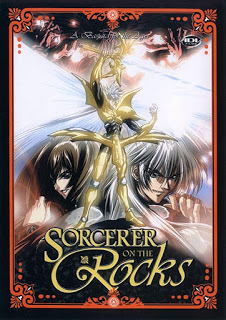 Sorcerer on the Rocks, 1999, dir: Kazuhiro Ozawa
Sorcerer on the Rocks, 1999, dir: Kazuhiro OzawaI feel slightly dirty for having enjoyed Sorcerer on the Rocks, and even dirtier for recommending that anyone else might enjoy it. Its main joke - nearly its only joke - is that the hero is a total and irredeemable bastard. And while the forms of his bastardy are many and varied, a lot of them involve being obnoxious to his assistant / lackey Gin Fizz, who's following him about in the thankless hope of saving whatever he has that passes for a soul. Whether it's dragging her around on a chain or forcing her to dance for chump change, our "hero" Shibas Scotch will sink to any depths without a second thought.
Oh, all the characters are named after alcoholic drinks. It's very much that sort of show.
Anyway, the point I was making is that Sorcerer on the Rocks is deeply obnoxious, and to cap it off, has the budget and running time of roughly two TV episodes, with nothing besides some moderately pleasing character work to recommend it on the level of style. It feels very much like a pilot that failed to be picked up, whereas in fact it's a spin-off from the show Sorcerer Hunters, which I suppose adds up to much the same. It's cheap tat, albeit tat made by people who clearly knew what they were about enough to produce respectable work with the odd nice visual detail here or there.
And also, lots of bare breasts. It's very much that sort of a show, too.
But, as the saying goes, all a comedy has to do is be funny, and Sorcerer on the Rocks is funny. Like, laugh-out-loud funny on occasions, with just enough of a baseline of mild amusement capped off with half a dozen really solid gags that you get to the end feeling you've had your comedic money's worth. And also, far more surprisingly, it has a decent story, with quite a startling number of twists and turns for its less than an hour of running time. Really, that's the aspect that surprised me more than anything: it's a remarkably terse and competent bit of storytelling, and that it manages to do that and not forget to be funny is actually an accomplishment worth celebrating, even if only slightly.
Nevertheless, it's certainly obnoxious, and it certainly does involve a woman being repeatedly humiliated for laughs, most of which really don't land, and it's certainly very inconsequential and not likely to stick in my memory past the end of this week. So obviously I'm not saying you ought to rush off and find a copy or anything like that. All the same, if you're truly craving a bit of unusually mean-spirited anime comedy, and the notion of a main character who really is an incurable wretch doesn't put you off, then it would be churlish to pretend I didn't enjoy the brief time I spent with it.
-oOo-
Sorcerer on the Rocks was undoubtedly the low point here, and yet, sad to admit, but weeks after I wrote the review, it actually has stuck in my memory, possibly because I immediately watched it again for some reason. Anyway, I still wouldn't pretend it's any good or anything, but as low points go, we've surely had lower. And the rest get a definite thumbs up: Voyage to Danger was a middling Lupin movie, but middling is pretty good where Lupin is concerned, the first Guyver volume was an unexpectedly fine example of the thing that it is, and this week's Black Jack marked the point where I really began to appreciate that I'd stumbled onto something special. Damn it, how has this not found its way to blu ray yet?
Next time: lots of Saint Seiya movies, for my sins!
[Other reviews in this series: By Date / By Title / By Rating]
August 24, 2020
Drowning in Nineties Anime, Pt. 76
The answers await! Let's take a look at El-Hazard: The Magnificent World, El-Hazard: The Wanderers, El-Hazard The Magnificent World 2, and El-Hazard: The Alternative World...
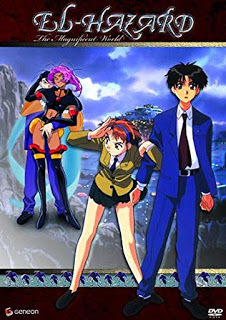 El-Hazard: The Magnificent World, 1995, dir: Hiroki Hayashi
El-Hazard: The Magnificent World, 1995, dir: Hiroki HayashiWhat's most striking about El-Hazard: The Magnificent World, some twenty-five years on from its original release, is how fresh it feels. More than almost any anime from the decade I could point to, it's the little details that give away its age rather than the big picture: the colour palette, aspects of the designs, and such. But not its plot, or it's world-building, or its attitudes, heck no; in those terms, it's on par with anything released in the subsequent two decades and change.
Our protagonist is Makoto Mizuhara, who early on encounters a mysterious woman in the basement of his school and finds himself transported, along with his teacher Fujisawa, his self-appointed arch rival Katsuhiko, and Katsuhiko's sister Nanami, to the land of El-Hazard - a fantastical, somewhat Middle East-inspired place of magic and science, poised on the brink of a war that of course our cast find themselves drawn into, with the mean-spirited, slightly mad Katsuhiko particularly eager to take sides.
So far, so half the fantasy stories of the last century or so, and it's in its specifics that El-Hazard the show begins to shine. A big part of the reason why, it's fair to say, is the presence of Hiroki Hayashi at the helm, the director also responsible for the first Tenchi Muyo OVA, a work that was similarly saved from being hackneyed by an unusual degree of inventiveness. The Magnificent World, if anything, leans farther in that direction: it's positively bloated with ideas. And whether it's sentient feline armour or militant bug people or clockwork goddesses or Fujisawa's splendid superpower, which sees him gaining in strength the soberer he gets, there are so many fun notions floating around that the show never seems stale. Along with that, every character's a distinctive creation, and most are intriguing enough to warrant more screen time than they get, even when they're present basically as a joke. And in many ways, they belong more to the twenty-first century than the twentieth; Makoto is forced to spend a good portion of the running time disguised as a woman, and there are a couple of openly gay characters, but if the show sometimes finds humour in those aspects, it's never mocking. Moreover, as with Tenchi, hints of harem anime conventions largely fall apart in the face of how satisfyingly written the female cast are. Sure, a couple of them have crushes on Makoto, but there's no bitchy rivalry and, thank goodness, not a single cooking contest.
All of that together would undoubtedly make for a decent show, but what pushes El-Hazard: The Magnificent World into the stratosphere is how gorgeous it looks. It really is at the top end of what an OVA could be in 1995, and many, many scenes would look completely appropriate on a cinema screen: indeed, much of the effects work, the marvellously evocative character designs, and the attention to detail are top notch by any standard. Because it is an OVA, the best is saved for the opening and closing episodes, the latter of which is particularly stunning, but never does it look remotely sloppy.
So with well-realised characters in an imaginative world wrapped up in some of the finest animation and design work the decade had to offer, we've got to be looking at a classic, right? Yes, I think we are, but I'd be remiss in not offering up a couple of caveats. One is that I'm not sure the OVA format does the material many favours; particularly toward the middle, I found myself wanting it to be either less episodic or less focused on its main arc, and it's easy to imagine this same material cut into two feature films and being better for it. But more importantly, while it's superbly told and laced with brilliant details, it's fair to say that the core story is The Magnificent World's least exciting aspect. This matters less than you might imagine: a solid story told superlatively is still pretty damn great, and the last forty-five minutes are so near to flawless that it seems petty to complain. Still, it's enough to keep one of my new favourite shows out of that handful of works I'd call basically perfect.
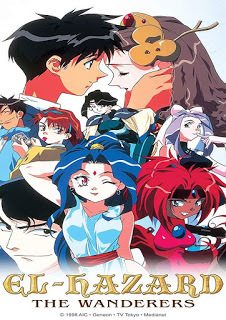 El-Hazard: The Wanderers, 1995-1996, dir: Katsuhito Akiyama
El-Hazard: The Wanderers, 1995-1996, dir: Katsuhito AkiyamaAccording to its Wikipedia article, the TV series El-Hazard: The Wanderers is a re-imagining of the Magnificent World OVA, and according to the dates both there and on the IMDB, that's clearly impossible, because they came out at the same time. But if we assume that, due perhaps to some sort of temporal loop of the sort El-Hazard itself delights in, this is true, it makes a degree of sense. If there was one criticism that could be applied to The Magnificent World, it's that its structure didn't quite fit its format, leaving aspects feeling rushed or detached from the grander narrative. And while the running time was sturdy enough for an OVA, you can easily see how the breathing room of twenty-six episodes might address those issues, while allowing the creators to dig deeper into their fascinating cast and world.
So it's a surprise that this isn't at all what El-Hazard: The Wanderers decides to do, and that, if anything, it strips away more than it adds. Though that isn't apparent for the first couple of episodes, which greatly decompress a beginning that's essentially identical to what we've seen before. This time, it's a scientific experiment Makota's been preparing that catapults him, Mr. Fujisawa, Nanami, and Katsuhiko to the magical world of El-Hazard, and Katsuhiko's spiteful interference with said experiment that's the catalyst, but we still wind up with Makota and Fujisawa in the land of Roshtaria and Katsuhiko joining that kingdom's enemies, the insectile Bugrom, while Nanami is stuck having her own adventures for a while.
Soon, however, changes become apparent. Roshtaria's princess Rune Venus is now Makota's primary love interest, and her openly gay sister Fatora has vanished from existence; the whole plot with Makota having to impersonate Fatora is likewise gone. Indeed, so is anything that might have been considered remotely radical, controversial, or particularly adult about The Magnificent World, to be replaced by an emphasis on light comedy and standalone stories. Amazingly, The Wanderers somehow manages to have less plot than its predecessor, and what there is can largely be boiled down to "Katsuhiko and the Bugrom make life difficult for the Roshtarians and Makota and his allies repeatedly foil them." It's late in the game when the Eye of God, so vital to the OVA, shows up, and only toward the very end when anything significant happens in relation to it, and though the principle theme in the first half is of Makoto and Fujisawa trying to get back to Earth, that quest loses steam fairly quickly.
Of course, a TV series not being the OVA it's drawing on isn't a crime, and if none of the changes are improvements, none of them are ruinous either, even if the removal of Fatora and the almost entire straightwashing of her partner Alielle feels depressingly censorious. This version of Makota is more interesting and proactive, the more comedic take on certain characters, notably Ifurita, frequently pays off, and a lot of the standalone episodes are plenty of fun. The Wanderers rarely sparkles - all else aside, the thoroughly middling TV animation sees to that - but it's generally pleasant and amusing, the sort of show that's easy to chill to for a fairly mindless twenty-two minutes. I can't imagine anyone preferring this to The Magnificent World, and I doubt I'll ever return to it as I'm sure I will the OVA, but as an opportunity to hang out with some of the cast at greater length and in more laid-back surroundings, I can't say I resented my time with it.
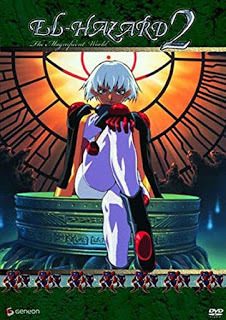 El-Hazard The Magnificent World 2, 1997, dir: Yoshiaki Iwasaki
El-Hazard The Magnificent World 2, 1997, dir: Yoshiaki IwasakiYou remember those straight-to-video sequels Disney used to bang out with horrifying regularity? They were calculated to look just enough like proper movies, and indeed like the proper movies they were follow-ups to, that undiscriminating parents would pick them up for their undiscriminating children. But though the character designs would be basically the same, the animators would be guaranteed to have trouble sticking to them, since they were operating with a fraction of the talent and an even smaller fraction of the budget. And though occasionally they'd have the virtue of being hilariously weird - Cinderella 3: A Twist in Time, anyone? - they could be guaranteed not to add a damn thing to the movies they were supposed to be expanding on, most of which left no real room for sequels. The best that could be hoped would be that they didn't actively sabotage their predecessors.
El-Hazard: The Magnificent World 2 is what would happen if Disney had produced a straight-to-video sequel to the original El-Hazard OVA. From its eye-wateringly crappy animation to its utter lack of inspiration to its failure to enhance a story that was perfectly whole in its own right, no other comparison fits so well. Anime, after all, has never had quite the cash-in culture that's plagued Western cinema practically since its inception; there's no guarantee that a sequel will be cheaper than the original, or for that matter that it won't merrily chuck out half of what was crucial to the original's success. Which makes it all the more striking both that The Magnificent World 2 exists - that impossibly lazy title says it all - and that anyone felt it a worthy continuation of one of the most lavish OVAs of the nineties. Remember how I said there isn't a moment's sloppiness anywhere in The Magnificent World? Well, here the opposite is true: aside from some decent effects shots and a couple of solid action sequences, there isn't a frame without its flaws. And sometimes those flaws are appalling and unmissable; it seems no-one on the staff, for example, understood what eyes look like at a distance. If you ever wanted to teach someone the differences between stunningly realised animation and cheap, shabby animation then - well, go with those Disney straight to video films, I guess, but if none are to hand, this would be the ideal substitute.
The problem, I suspect, was that El-Hazard: The Magnificent World was a little too perfect, leaving no conspicuous threads that begged to be tied up and so no meaningful direction in which a series could develop. What we get instead is a tale that almost has to trample on the toes of its predecessor, making explicit what was gently implied, digging into aspects of the world-building that were more satisfying left vague, and outright ruining at least three of the characters, either by bringing them back in the most depressing ways imaginable or misrepresenting them so badly that they're unrecognisable. Even if that weren't the case, its reliance on outrageous coincidence and joyless comedy to get its ducks in a row, in service of a plot that couldn't dive harder into anime tropes if it tried, would make it shockingly lacklustre. Take this same material wrapped up in this same animation but peel away the El-Hazard brand and it would be middling at best, but try and present it as a meaningful follow-up to one of the finest OVAs of the decade and the result is a hard slap in the face.
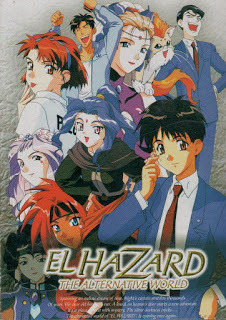 El-Hazard: The Alternative World, 1998, dir: Yasuhito Kikuchi
El-Hazard: The Alternative World, 1998, dir: Yasuhito KikuchiThe Alternative World, the final iteration of the El-Hazard franchise, certainly makes a promising initial impression. There's the sense, wholly absent from the second OVA and only there in part in the TV series, that the creators understood what made the original so successful. One vital point was that it wasn't so much the world of El-Hazard that was special, more its overt strangeness and the way the viewer was kept at a certain remove; here was a setting that never stopped feeling unfamiliar, and a steady enough stream of concepts and locations was thrown in for that alienation to carry through until the end. On the other hand, with so much hand-waving and vagueness in regards to the world-building, there was more need than ever for a strong cast to focus on, and The Magnificent World pulled that off too, while both the setting and characters benefited from being brought to life with such top-tier animation.
With The Alternative World, the creative team had sense enough to realise they couldn't pull the same trick twice: especially with the series being a thing by this point, there was little to be done that could bring back the exciting strangeness that made El-Hazard such an appealing setting. So instead, they cheated: a magical gizmo shunts the core cast, plus a couple of new members, into a new setting, Creteria, with its own distinct and notably more futuristic vibe. Not only that, they find themselves scattered into small groups that are perfectly suited for everyone to go off and have their own adventures before coming together in time for the finale. And while none of this looks anywhere near as good as the original OVA, it's a step up from where we've been since: the animation is crisp and polished, and if there aren't a great many wow moments, it's at least comfortable on the eyes.
Sadly, for all that The Alternative World gets off to a good start, that's not quite enough to carry it through to an equally good ending. Mostly the problem is the tale it's telling, which turns out not to be terribly interesting, and also falls back on rehashing a crucial aspect of the original in a manner that undoes much of the good work in stepping away from El-Hazard in the first place. That would be less hurtful if it wasn't happening at the expense of the various subplots, which largely fizzle out, having served as a means to show us the sights of Creteria and give a sense of how the place works. There's a big difference between keeping your cast busy and giving them meaningful plots to advance through, and by its end, The Alternative World has done lots of the former and too little of the latter.
With that said, even if this last gasp of the El-Hazard franchise isn't a perfect return to its lofty beginnings, it's probably the most successful attempt at reproducing them, and so the sequel that feels least dispensable. There's definite fun to be had in hanging out with these characters again, especially in the first half, when that means watching them come to grips with a new environment and unpredictable challenges, be it Fatora indulging in a castle break-in that feels like Ico played for laughs or Jinnai falling foul of a version of the Bugrom very different to the ones he's accustomed to. Therefore, even if the best material is bunched in those opening chapters, at least there is good material, and if you're fond enough of the El-Hazard gang to overlook a few wider failings, that's enough to make it worth seeking out.
-oOo-
Sad to say, it's fairly evident why El-Hazard didn't have a longer innings: only the original OVA was truly special. The TV series was fine and The Alternative World was somewhat better than that, but neither felt like a necessary extension of what had come before, and neither did a good job of opening up the El-Hazard universe in ways that would make the notion of further sequels appealing.
On the plus side for the purposes of this reviewing exercise, at least we have a clear result: The Magnificent World is brilliant and you absolutely ought to try and find a copy, but that's as far as you need to go. After that, if you're really in love with the characters, The Alternative World is worth a crack: go in with lowered expectations and there's plenty of engaging stuff there. And just for goodness' sake don't get mixed up and inadvertently watch The Magnificent World 2 instead!
[Other reviews in this series: By Date / By Title / By Rating]
August 21, 2020
Writing Ramble: Nothing's Ever Really Finished
I've been thinking a lot recently about a topic I've often considered over the years, and that I may even have blogged about before now: how there's always room for improvement in writing, however far along your career is and however much you feel you've nailed down a particular piece of work. Now, that's abundantly not to say you should never let anything go; not putting work out into the world because it's insufficiently perfect is one of the archetypal writer mistakes. As a wise man once said, if you never get anything a bit wrong, you'll never get to subsequently feel like such a dumbass that you don't make that same mistake ever again.
No, what I'm talking about is more along the lines of returning to work after months or years and really bringing a fresh perspective. And the reason that's been occupying my thoughts is that I've been spending a lot of my time editing up short fiction. This began as an attempt to finally start subbing some pieces I've written in recent years and had to step away from to focus on novels - the first of those to see the light being Not Us, coming very soon in Nightmare! - but has since expanded to take in others I've been sending out without success for years and that I felt were too good to give up on.
One such is a story called Compassion Fatigue, which I've long regarded as among my best short work and been baffled and faintly annoyed as to why editors seemed to disagree. And, look, I'm not going to turn around and say that everyone who turned it down was in the right, exactly - but returning to it certainly was an insight into how I've developed as a writer in the years since I last looked over it. Yes, the story was good, and probably one of my best, but the execution let it down in ways both big and small. The theme was obscured in places, where it was evident I'd left in first-draft material that ought to have been excised, attempts to wrong-foot the reader on a crucial plot point were wildly misconceived, and there was enormous repetition and overuse of certain words, something I've become extra sensitive to in recent months.
What was most striking, though, was the amount I cut. Pro tip: shorter stories are more saleable, and 3000 to 5000 words is a definite sweet spot. Compassion Fatigue was over 6000, and it didn't take me long to appreciate that there weren't 6000 words of narrative there. I set out to get it down below the golden 5000 mark, but without much hope, because it was one of my better stories, wasn't it? And surely I wouldn't have left over a thousand words flopping about when they could have been trimmed with a more judicious edit? Well, not exactly; there was definitely some killing of darlings to be done to reclaim that lost ground. And yet it absolutely did turn out to be possible, and more to the point, beneficial. Some nice lines got sacrificed to the cause, if I do say so, but every one was slowing the pace or repeating points that had already been made or providing detail and texture that wasn't really necessary. In the end, I broke my target with room to spare, and there was precisely one line I felt genuinely sad to see go, and that got cut simply because other cuts had stranded it between two paragraphs. These things happen sometimes.
As a commercial exercise, I suspect this is a terrible waste of energy: I'd need a pro sale and then some to pay for all the hours I've poured in, and given that all the pro markets have turned it down, the odds aren't favourable. But then, with all my major projects handed in and nothing on the horizon - yes, that's as bad news as it sounds, but a topic for another day - I have a certain amount of time to waste, and also an opportunity to decide what matters to me if I can't turn things around in the coming weeks. Short fiction was always my first love, and I feel less inclined than ever to give up on stories I know in my heart deserve to see some success. So fingers crossed, right? Maybe I'll find a good home for Compassion Fatigue one of these days, and if and when that happens, it'll be a damn sight better than it would have been if I hadn't put this extra work in.
August 17, 2020
Drowning in Nineties Anime, Pt. 75
This time around: Crying Freeman: Abduction in Chinatown, Black Jack: Seizure, Amazing Nurse Nanako, and Lupin the 3rd: Dragon of Doom...
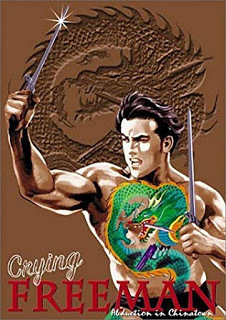 Crying Freeman: Abduction in Chinatown, 1992, dir: Shigeyasu Yamauchi
Crying Freeman: Abduction in Chinatown, 1992, dir: Shigeyasu YamauchiAs a rule, you don't expect a six-episode OVA series that's barely nosed its way up to mediocrity to suddenly become good in its final third, and the problems that beset Crying Freeman seemed pretty ingrained: an all-over-the-place tone, such an emphasis on sex and violence that it ended up feeling more juvenile than adult, and a budget that left the animators constantly failing to replicate the highly detailed images of the source manga. Yet here we are, and here's the third volume of ADV's annoyingly divided release, and the final pair of episodes are such an improvement that I barely know what to make of it. Though the first thing would be to note that I did director Shigeyasu Yamauchi, who also handled episode four, a huge injustice last time around, when I dismissed his work as stylish but incompetent. That may have been true there, but it isn't here, and the leaps in ability he shows over a scant few years are extraordinary.
Episode five is the first I'd describe as legitimately, consistently well directed, with a flair for visual storytelling that's been largely absent so far. It helps greatly that the crew have finally figured out how to get the look right: gone are the experiments in impractical shading that scuppered the previous part and this time around we have yet another step up in realism, kept within what presumably still wasn't a grand budget by a reliance on still frames that would normally be ruinous, but in Yamauchi's hands is expertly balanced. And all this is in service of a story that engagingly fills a full fifty minutes, though it has to be said that it frequently does so by drifting into being flat-out pornography, something Crying Freeman has always been inclined toward. Still, if you accept that sex and violence are basically what this show's about, at least they're delivered with some real panache.
But then along comes episode six, and if the previous step up in quality was surprising, this one is astonishing. Episode five reached the dizzy heights of pretty good; the final part is superb by any measure. And though the familiar ingredients are there - there's a lot of bloodshed and a lot of nudity, most of it female - there's also a pointed departure from many of the sillier elements that have dragged the series down. It's the most genuinely standalone story thus far, a battle of wits between an ambitious gangster and the Freeman and his 108 Dragons organisation where the latter are kept largely in the background, meaning that what we get feels more akin to a Yakusa picture in the Battles Without Honour and Humanity vein than the usual fare. And it looks stunning: here at the end, Yamauchi has won the show's battle with the manga's practically unadaptable visuals, aided by what appears to be a sizeably increased budget, meaning that, at last, the best stuff isn't relegated to stills. Add to that a fine eye for interesting locations, all beautifully painted, and a grasp of how bodies appear in motion that was desperately needed in the previous volumes, and you have a true visual treat. But most striking is that, though the story feels independent of what's come before, it nevertheless bring events to a satisfying close, making the entire OVA more worthwhile.
Take that all into account, and I find myself with one of my more bizarre recommendations: if Crying Freeman appeals, I really would consider skipping the first two volumes and picking up here, or at least ignoring the middle portion. Of course, it's available on one disk via Eastern Star these days, but since that's also fallen out of print, it's not significantly easier to find than the old releases. Frustratingly, Abduction in Chinatown is hardest to lay hands on, but it's also genuinely excellent and well worth hunting down. It's maddening that it took so much failure to produce so fine a take on the material, and more maddening that we couldn't have had a couple more episodes on a par with these last two, but in the strange world of nineties anime, you take what you can get, and a great ending's better than nothing.
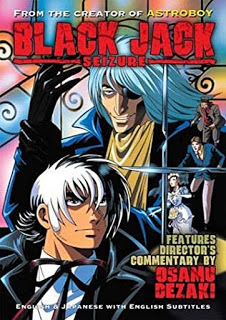 Black Jack: Seizure, 1993, dir: Osamu Dezaki
Black Jack: Seizure, 1993, dir: Osamu DezakiThere's no easy way to review the Black Jack OVA series, which U.S. Manga Corps released in drawn-out fashion and under their own titles that have nothing to do with the original episode titles. And even if there was, I probably wouldn't be the person to do it, because the head director was Osamu Dezaki, who I used to consider among my least favourite directors for his weird stylistic excesses and have since developed a certain fondness for, while still having my share of issues.
To further complicate matters, this disk, unlike the majority of those U.S. Manga Corps put out, contains two episodes, and while they're both good, one is notably better than the other. First, and weakest, we have Decoration of Maria and Her Comrades, a tale that finds surgeon-for-hire Black Jack in South America, treating a revolutionary hero on the run from an attempt by the US (it's actually the Federal Unites, but trust me, it's the US) to frame him for fictitious crimes. It's a terrific setup, with a real sense of sweaty desperation and some deft character building across its fifty-minute running time, but it finds Dezaki at his borderline worst, going nuts with his stylistic tics to the point where they start getting in the way of the material. It's almost more frustrating because I'm come to appreciate his very real talents, and it's annoying to see him deploying his grab bag of tricks so clumsily, especially when the passages where he reins it in are so much better. Nonetheless, it's a well-above-par story that suffers only from being told in a sometimes needlessly annoying fashion.
Then we have Anorexia, The Two Dark Doctors, an episode pretty well summed up by its title: a young actress trying to make her break from an early career in pornography is suffering from anorexia so severe that she can't ingest a thing, and Black Jack is called in to save her, but finds himself competing with another black market doctor who offers a more terminal brand of care to patients who've lost all hope. What results is a thoroughly tangled tale with a couple of gigantic red herrings and a climax you couldn't guess in a million years, and yet somehow feels right for the material when it could easily have come across as absurd. And here the direction isn't distracting but a huge asset, and so distinct from the previous episode that I can only assume Dezaki was letting a co-director do much of the heavy lifting; certainly the credits suggest a sharing of authority, though it's not clear where it lies. At any rate, whoever was responsible for what, it's a cracking short film.
Having not been a huge fan of the Black Jack movie, also directed by Dezaki, I hadn't hoped for much from this one, so colour me both impressed and surprised: even if the two episodes here are less than equal, they're both quality work, telling novel, adult tales using a fascinating, unusual protagonist, and doing so with impressively slick animation and a sense of style that varies from the distracting but inventive to the truly excellent. Even if you've no interest in the wider series, as a standalone release this one's well worth searching for.
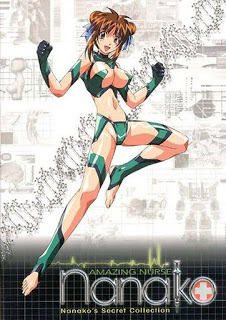 Amazing Nurse Nanako, 1999, dir: Yasuhiro Kuroda
Amazing Nurse Nanako, 1999, dir: Yasuhiro KurodaFor the first two of its six episodes, it's impressive what a terrible job Amazing Nurse Nanako does of combining two genres that anime had been gelling with great success throughout the entirety of the nineties. Mostly it's a comedy, insomuch as you can use the word for a show that really only has variations on a single joke, whereby something humiliating and / or unpleasant happens to its ditzy heroine, the titular Nanako, often involving some or all of her clothes coming off. Then, whenever that's not happening, there are a couple more plot lines going on, both telling different angles of a sci-fi narrative and neither making any particular effort to be funny, even by the lowly definition the rest of the running time is gunning for. All of which is to say that Amazing Nurse Nanako gets off to a lousy start.
There are, it turns out, reasons for some of this, and as the plots come into focus around the midway point, those reasons even make a degree of sense; a couple of later twists and turns rely on us not having much idea of how the Nanako elements fit the wider picture. That picture revolves around Nanako's primary tormentor, Dr. Kyogi Ogami, scientific genius and owner of the hospital at which Nanako, despite the title, does no nursing whatsoever. We learn early on that Ogami is experimenting on Nanako herself, for what appear to be malicious reasons, and that this relates to why he's drawn the attention of both a military bigwig and a high-up church official, the former wanting him to investigate an alien life form they've happened upon and the latter after his assistance in bringing Jesus back to life. And yes, you did read that right.
This probably makes Amazing Nurse Nanako more offensive to Christians than it is to people like me who find this brand of fan-service-heavy comedy largely obnoxious, but then again, it's not worth the effort of getting offended by whoever you are. It's sexist and possibly blasphemous - is the notion that the church might use mad science and alien DNA to resurrect the messiah blasphemy? - but the show has its tongue so firmly in its cheek that it's probably better to smile tolerantly and let it get on with what its doing. Maria Yamamoto's weirdly committed performance takes some of the sting out of the sexism by making Nanako into a vaguely relatable human being, and once the show finds its feet enough to decide what its pastiching and what its core concept is, there's a lot more fun to be had, not to mention the makings of a solid story.
Mind you, it's easy to imagine a much better version of Amazing Nurse Nanako, one that doesn't get off to such a rocky start and plays up its best elements instead of indulging in the sort of jokes the sub-genre had mined to death by this point. And while the animation is more respectable than a lot of what was happening in 1999, there's still evidence that the industry was dead set on using computers without quite having figured out how: in particular, the overly dark colouring has the air of something knocked together on a PC because it could be rather than because the results would be aesthetically pleasing. Which I suppose works as a decent metaphor for Amazing Nurse Nanako in general: squint hard and ignore its attempts at self-sabotage and there's definite pleasure to be found here, but it's a shame the makers felt the need to make discovering it such a chore.
 Lupin the 3rd: Dragon of Doom, 1994, dir: Masaharu Okuwaki
Lupin the 3rd: Dragon of Doom, 1994, dir: Masaharu OkuwakiIf there's one thing that's routinely impressed me about these Lupin TV specials, it's how little they've felt like TV specials. Oh, nobody would be likely to confuse them with cinematic releases, but they certainly tend to inhabit a comfortable middle ground, with sufficient production values and enough creative ingenuity to at least make them entirely worthy of DVD releases all these years later.
Not so Dragon of Doom, which feels like precisely what it is from the beginning, a particularly damning fact when the opening scene is as good as things get: certainly a sequence of our heroes being chased through a city by ninjas is the closest it comes to satisfying action. But even in its better moments, the film has an air of cheapness and unambition, and Okuwaki hasn't the directorial chops to do anything about those shortcomings. Indeed, quite the opposite; his directorial style reeks of TV work, with unimaginative compositions and a tendency to slap everything in the middle of the boxy old 4:3 ratio frame, where we can't hope to miss it. There's not much to get excited about here on the level of animation or visual storytelling, and that's a real blow coming from a franchise that frequently succeeds better than most on both fronts.
Fortunately, the narrative is somewhat stronger, enough anyway that it's possible to imagine a superior movie being built on these bones. It's nice to see a plot making meaningful use of the samurai Goemon and his preternaturally sharp katana Zantetsuken, and a heist from the wreck of the Titanic feels so perfectly Lupin-esque that it's a wonder they never got to it before. But it becomes apparent long before the end that there aren't ninety minutes of ideas here, and too much of the running time gets absorbed in nondescript shenanigans of the sort the series can knock out in its sleep, with the back half flinging those elements about in a fairly random-seeming manner. (Less than twenty-four hours later, I can't remember how this ended, though presumably it did.) Nor does it make use of the characters in remotely interesting fashion, not even Goemon, who gets neglected even more than usual despite a story you'd think had been designed to give him a touch of depth. As is often the case, it's femme fatale Fujiko and bumbling cop Zenigata who fare the worst, with Fujiko reduced to being slutty and double-crossing, as she is in all the lousiest Lupin entries, and Zenigata trapped in unfunny comedy relief hell.
If I had to find a positive, and that's a personal rule for these reviews so I suppose I do, I'd admit that Dragon of Doom is perfectly fine and watchable, since it's a Lupin movie and Lupin movies have to go very far indeed off the rails to lose all appeal whatsoever. (I'm looking at you, The Secret of Twilight Gemini!) It's a functional story told in a functional manner, but within a basically engaging comic universe that contains some rightfully legendary characters. Nevertheless, when there are so many better entries out there, it's hard to see why you'd want to waste time on this one. What no doubt just about did the job for an hour and a half on TV twenty-five years ago fares far less well today.
-oOo-
Who would have thought Crying Freeman would come good at the end, huh? And not just good but really, really good; that last episode is a blinder. And as if that weren't shocking enough, we have another Osamu Dezaki title that I both like and admire - a slight spoiler, but I'm quite a way through the Black Jack OVAs now, and it's a truly superb series. Then again, Amazing Nurse Nanako was rather a disappointment, mainly through squandering some real potential, and Dragon of Doom was comfortably the second worst Lupin entry I've seen. I'm glad it's not the last of this little Lupin marathon I've had going on, because it would have been a sad note to end on.
[Other reviews in this series: By Date / By Title / By Rating]
August 12, 2020
Drowning in Nineties Anime, Pt. 74
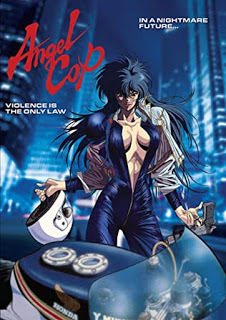 Angel Cop, 1989, dir: Ichirô Itano
Angel Cop, 1989, dir: Ichirô ItanoI confess, I bought Angel Cop more out of a sense of duty than anything else. It's one of a tiny handful of the early Manga Video releases I hadn't seen, and also one of the most notorious. Watching five minutes from the first episode was enough to push it even further down my list of priorities; the combination of animation that was truly horrible in places and outrageous gore hardly seemed a winner. Then there was the disclaimer that Eastern Star tacked on, washing their hands in advance of a title that's famous for basically one thing all these decades later: to the routine failings shared by many of the more conspicuously nasty shows coming out of Japan in this period, Angel Cop adds a sprinkling of antisemitism, making its villains a cabal of evil Jews straight out of The Protocols of the Elders of Zion. Given that Eastern Star also include an essay on the topic, it's easy to suppose they released this for some pretty sleazy reasons: there's something awfully tacky about their position of "this is deeply offensive and we don't condone it, but hey, if you really want to watch it!" And to pile insult on injury, this has to be the worst print they've issued, and if you told me it was precisely the same crummy print Manga put out all those years ago, I wouldn't doubt you.
After all that, I'm obviously not going to turn around and tell you that just maybe you ought to find a place in your life for Angel Cop, but ... okay, I'm going to do precisely that. Is it vile and offensive? Yeah, it really is, brewing a heady cocktail of ultra-nationalism and xenophobia that's only saved from true ugliness by being muddled and hard to parse. The thing is, Angel Cop hates everyone and anyone. This should make it dreadful, and perhaps does, but there's something oddly egalitarian about the way it refuses to vindicate anybody. Its villains are frequently more sympathetic than its heroes, who are largely monsters; one of the most unpleasant sequences is a torture scene that we can't possibly be expected to be on side with, yet it's enacted by what are ostensibly the good guys. Insomuch as it's possible to have sympathies with the characters, it becomes a matter of switching them on the fly depending on who's least wrong at any given moment.
That's still arguably not a reason to give up three hours of your time, so how about this? Angel Cop has some terrific action. Oh, not in the first episode, perhaps, that really is ugly and shoddy, but the animators largely sort themselves out after that, and there's some real talent operating here. But where the action succeeds, it's more at a conceptual level. Sometimes that means a three-way battle in an apartment building where our loyalties keep shifting as the situation goes from bad to worse; sometimes it means giving the entire back third up to an epic cyborg-versus-psychic-monster-lady showdown. In general, it feels like a compendium of much of what was succeeding at the time, with a trace of Patlabor here and a hint of Bubblegum Crisis there and a dash of Harmagedon-style psychic warfare to top it all off. And though the fashion in which it takes all of this tremendously seriously arguably makes its nastiest elements all the scuzzier, it also provides a grittiness that pushes the violence past the point of easy shock value into genuinely shocking territory. Beyond the midpoint, there are character deaths that really got to me, far more so than ones in many a notionally better title.
Also, I'd be remiss in not mentioning that Angel Cop has one of the best end themes anywhere in pre-twentieth-century anime, a barnstorming musical panic attack that elevates the material just by existing. Honestly, I like that tune so much that I'd have given this a hesitant thumbs up even if it had been precisely as bad as I feared it would be. Heck, I'm still not sure it isn't, and you absolutely need to go in with your eyes open: it's unpleasant in ways that only a tiny handful of anime titles that made it to the US and Europe are, and that bit worse for propagating some utterly shameful views. But if you have any affection for the sort of dark, violent anime that was such a big part of the medium's migration to the West, the fact is that Angel Cop delivers better than most. Just for goodness' sake opt for the new subtitles over the burning garbage heap of a dub Manga vomited out, unless you're determined to push your viewing experience into laughably awful territory.
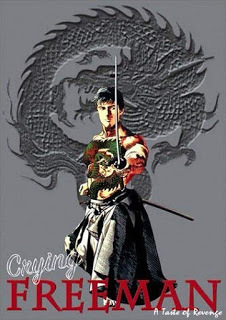 Crying Freeman: A Taste of Revenge, 1990 / 1991, dir's: Daisuke Nishio / Shigeyasu Yamauchi
Crying Freeman: A Taste of Revenge, 1990 / 1991, dir's: Daisuke Nishio / Shigeyasu YamauchiThis second volume of Crying Freeman doesn't have to put up with me making comparisons to its Western live-action adaptation, as I did with the first, since we're well beyond the material covered in the movie. And this is a good thing, because it's becoming increasingly apparent that Crying Freeman the anime needs all the help it can get. Among the many factors not doing it any favours is ADV's original insistence on releasing it over three disks, despite there being no reasonable way of breaking the material up like that. That's all the more apparent with this second volume, because it contains the back end of the story begun halfway through the previous volume and then an episode with a different director and noticeably different style that also makes subtle changes to the format. Until that point, multiple storylines have been bundled into each episode, and that's particularly evident with episode three, which simply moves onto a whole 'nother plot at the halfway mark. Mind you, this actually proves somewhat to its benefit, in that - despite having watched it less than twenty-four hours ago - I can barely remember the first half, in which the titular Freeman squares off against an African terrorist organisation. Whereas the back end, where female lead Emu Hino (now named Hǔ Qīng-Lán for reasons) gets to occupy the spotlight for a while, at least takes the material in a different direction.
Of course, this being Crying Freeman, occupying the spotlight largely means being naked a lot, so maybe it's not all that different. And, look, I've nothing against nudity, but here it makes a breathtaking lack of sense, unless you accept that this is a subtly different universe in which women have unanimously decided that fighting with their clothes on would be plain crazy. Anyway, if that was the extent of the show's horrible attitude to women, I'd be more inclined to give it a pass; episode four opens with a particularly nasty sequence in which a female character is raped and almost murdered that left a sour note throughout what was otherwise the strongest episode yet. Yamauchi isn't a very good director, as his predecessor Nishio wasn't a very good director, but he does bring a greater sense of style that lends much-needed energy. I mean, I don't know that it's good style, but it's something.
Unfortunately, Yamauchi and his team also make the bewildering decision to try even harder to replicate the highly detailed look of the manga this was sourced from. Or rather, that would be a sensible decision if they had the budget to pull it off, but what we instead get is a show that's exactly as cheap-looking as always, but with the addition of complex shading of a sort that's entirely impossible to animate, resulting in visuals that are intermittently great in stills and routinely dreadful in motion. Still, thanks to the aforementioned focus on a single plot for the full fifty minutes, and ignoring as much as possible what an unpleasant note it opens on, episode four marks a slight step in a positive direction.
Indeed, I'd be lying if I said there's nothing to enjoy here. The Crying Freeman universe has a kind of insular weirdness that's sort of appealing, at least while you're watching. Much of what happens makes no objective sense, and lots of it is unpleasant, juvenile, silly, or all three, but those qualities stand out less in the moment. Beneath the tacky animation and the horribly elevator-music score, you can see how this heightened narrative of sex and violence could function, and presumably did in the manga. As such, while it isn't good in any meaningful way, it has a certain hypnotic charm - and a twisted part of me is eager to see what madness the third and final volume has to offer.
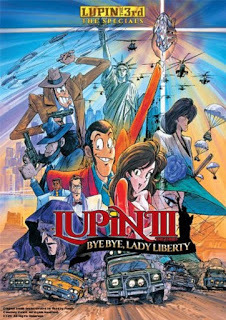 Lupin the Third: Bye, Bye, Lady Liberty, 1989, dir: Osamu Dezaki
Lupin the Third: Bye, Bye, Lady Liberty, 1989, dir: Osamu DezakiI've been so rude about poor Osamu Dezaki in previous posts that it seems hypocritical to turn around and say that he's far and away my favourite Lupin director - yes, even over Hayao Myazaki! - and yet there it is: based on what I've seen, no-one understood the character more or made better use of the formulaic elements that compose the Lupin universe. His take is now what I expect a Lupin film to be: regular bursts of manic action, slapstick comedy, preposterous technology, multiple plot strands that combine by the end, a varied set of locations, and a MacGuffin of a treasure for everyone to chase after that probably won't end up in our hero's hands by the end.
And here we are with Dezaki's first take on the series, and all those elements are firmly in place, though that isn't to say Bye, Bye, Lady Liberty is precisely business as usual. Its twists include some deeply strange villains modelled on the Freemasons (and not very subtly, since they're called the Three Masons!), a shift in setting to the USA that, given how rooted Lupin is in both Japanese and European culture, feels surprisingly natural, and, least appealingly, the addition of a child character who almost seems intended as some sort of young sidekick. Actually, thinking about it, the plot really is sheer lunacy even by Lupin standards, with highlights including the theft of the entire Statue of Liberty, the subsequent hiding of said statue with what appears to be toilet paper, a bonkers sequence in which Fujiko gets possessed, and an excellent climax as Lupin and the gang square off against the cultists and their giant supercomputer.
That aside, it's very much what you'd hope for as far as these TV specials go, which is to say, pretty impressive. Perhaps you can't quite mistake them for cinema releases, but they're not far off, and while I'm complimenting Dezaki, he does have a knack for stretching a budget. There's some marvellous, complicated action, including a noteworthy run-in with an armoured truck in the first third, a real sense of place and scale that makes the most of the shift to the US, and, here as in the other Lupin movies, Dezaki's many stylistic ticks feel like an asset rather than the annoyance I've found them to be elsewhere. Visuals-wise, the only drawback is a couple of ghastly character designs, the worst of which belongs to aforementioned precocious child genius Michael, who not only feels as if he's wandered in from a much worse film but looks as if he has as well. As flaws go, he's a relatively negligible one, in part because his role turns out to be less intrusive than initially seems like it might be the case and in part because there are narrative reasons for his presence that pay off rewardingly. Still, he makes some early scenes grating, and surely nobody comes to Lupin for grating child characters.
In the end, I'm finding these Dezaki movies to be much of a much, and I wouldn't pretend that any of them are masterpieces in their own right; objectively, none are on a par with Miyasaki's wonderful Castle of Cagliostro. On the other hand, the giddy frivolousness and anything-goes vibe that keeps them clear of classic status is what makes them work tremendously well as Lupin films: Dezaki nailed the tone for this character and his supporting cast, and that tone is immensely fun, even as it never rises to being deep or meaningful. Bye, Bye, Lady Liberty isn't my favourite, the annoying Michael sees to that, but it's definitely memorable, staying within the bounds of an entertaining formula while offering enough tweaks and weird asides to feel very much its own thing.
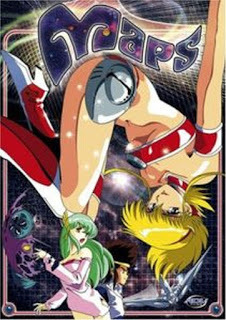 Maps, 1994, dir: Susumu Nishizawa
Maps, 1994, dir: Susumu NishizawaOne of the harsh realisations you come to as a fan of anime, particularly of older anime, is that sometimes this stuff just isn't meant for you. Oh, not in any kind of exclusionist cultural sense; rather, it's often the case that anime is adapted from a manga or novel, and frequently the goal is not to make new converts but to please existing fans, by giving them a glimpse, however brief, of how a story they love would look in motion.
And so it is with Maps, which couldn't race through its space opera tale much faster if its tail was on fire. This is frustrating indeed, because the ingredients are terrific: by the time the alien pirate who's approached our hero Gen to explain that he's the lost descendent of a race of intergalactic mapmakers drops in off-handedly that she's the living incarnation of the city-sized, angelic spaceship she arrived in, I was fully on board with its excitingly crazy universe. But at the same time, therein lies the problem: you can't hurl ideas like that at the viewer at a rate of roughly one every five minutes and expect them to keep up. Or rather, you can, but it doesn't take long for the process to grow wearing. We don't just come to science-fiction to be presented with concepts, after all, we expect them to be articulated via engaging characters and embedded in intriguing plots.
Not that Maps entirely fails to do that. Gen himself is awesomely dull and his girlfriend Hoshimi plays so little part that you wonder why they included her, and even Lipmira the pirate who's also a sentient spaceship is a bit of a cipher once you get past her fantastic character concept and solid design. But once the busy setup of the first episode is over, we do get some villains and side characters who brighten the proceedings, and indeed the second episode, probably the best of the four, tells a perfectly enjoyable and reasonably self-contained story. It's easy to imagine this being genuinely special at perhaps twice its current length, with more time to build the world and cast and simply to take the pedal off the metal occasionally, and to avoid situations like the jarring revelation at the start of the second episode that an entire year has gone by.
That, though, isn't what we get. What we get is a breakneck tour of what was probably a really cool manga, and one that's definitely good enough to give us that sense of how cool the thing we're not getting would be, but rarely works in and of itself. There's simply too much and too big of a story here for under two hours, and there's rarely a point where that isn't apparent. Nor is there enough flair to the telling that we can easily miss that flaw: Nishizawa wrangles some strong moments from his material, but generally his handling is fairly conventional, down to some annoyingly intrusive fan service and a general sense that this should all feel much bigger and weightier than it does. And, despite a title card that feels the need to claim the show has "high quality animation", the animation is actually more in the region of respectable, with some striking imagery but also plenty of evidence of budgetary restraints. That's fine for what Maps was probably intended to be: a taster of a bigger narrative and a reward to its fans. But here we are, two-and-a-half decades later, and sadly all that means is a title that can't quite stand on its own feet.
-oOo-
Ultimately that was quite a surprising batch. I absolutely didn't expect to rate Angel Cop so highly - I'm still not altogether certain I should have, even putting aside its least savoury aspects - and this middle chunk of Crying Freeman was at any rate better than I'd have anticipated given how extremely rough around the edges the first was. Whereas Maps I'd been quite hopeful for, perhaps for no other reason than that it was terribly obscure and I tend to count that as a virtue when it comes to anime. Indeed, only Bye, Bye, Lady Liberty was more or less what I'd hoped it would be, and how bizarre is it that Osamu Dezaki has become the guy I rely on for a quality watch? Very bizarre indeed, that's how.
[Other reviews in this series: By Date / By Title / By Rating]
July 27, 2020
Drowning in Nineties Anime, Pt. 73
Well, whatever, let's run with it! Here in the Drowning in Nineties Anime scarily-aggressive-naming-that-may-or-may-not-include-the-word-fight special, we have Fight! Iczer One, Lupin the Third: Island of Assassins, Fight!! Spirit of the Sword, and Crying Freeman: Portrait of a Killer...
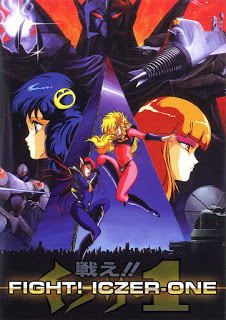 Fight! Iczer One, 1985, dir: Toshiki Hirano
Fight! Iczer One, 1985, dir: Toshiki HiranoThere are great movies, and then there are great B-movies, and anime has produced more than its share of both over the years, but I don't know that I could point to a finer example of the latter than Fight! Iczer One. It's the B-movie par excellence, and particularly the anime B-movie par excellence, doing an abundant amount of stuff and doing it all with such skill and verve and demented commitment that it rarely ceases to impress.
Of course, strictly speaking, it's not actually a movie but an OVA in three parts, but aside from a lengthy plot recap at the opening of the third and longest episode, it flows together so smoothly that it might as well be a film. Indeed, it's surprising that the re-cut movie version put out in Japan never found its way to an international release; so far as I know, this wasn't given much of a push by publisher AnimeWorks, perhaps because it was old news by the time they got to it. As such, Fight! Iczer One remains relatively unknown, though it's one of those titles that serious vintage anime nerds mention often in hushed whispers. And no wonder! Like I said, it's excellent, but it's also a compendium of just about every trend that was going on in the world of late eighties and nineties Japanese animation, flinging around giant robots and body horror and big-ideas sci-fi and even a few tentacles with cheerful abandon. The plot that this is in service of is fairly nondescript, but that barely counts as a criticism, because plot would only get in the way of its breakneck pace and heady stylishness.
And it's very stylish indeed, with an aesthetic that at once screams of the late eighties - see our hero Iczer's impossibly garish costume and ginormous hair - and has enough originality to hold up pretty well even today. In terms of craft, there's much less that says eighties animation rather than nineties, besides the somewhat more rounded character designs; at any rate, it frequently looks stunning, with no end of detail and fluidity and something absolutely eye-popping happening at a rate of roughly once a minute. Come to think of it, that's often someone's eyes popping out, because Fight! Iczer One spends quite a bit of time being gross, exploitative, and trashy in various combinations, which normally I'd count as a flaw, but here is delivered with a combination of general kind-heartedness for even its most villainous characters and such unadulterated glee that it's impossible to take offence. In theory, it's all quite dark and nasty, but among the virtues that director Hirano brings is a joyful energy that refuses to let the material sink into grimness when the alternative is more fights, more explosions, more cool shots, more everything. Underscore that with composer Michiaki Watanabe's delightfully hyper music and the results are compulsive entertainment.
And here we are at the end and I'm conscious that I've not done a very good job of selling Fight! Iczer One, or even of pinning down precisely what it is, in part because it's so all over the place that it's hard to know how to begin summing it up. Nonetheless, you'll have to trust me on this one; if you've any fondness for horror-tinged science fiction and enjoy good animation, it's tough to see how you wouldn't like it. Fight! Iczer One is a true lost gem of vintage anime, and like all great B-movies, an example of how bonkers trashiness can become transcendent and thrilling if you throw enough heart and passion and raw talent into the mix.
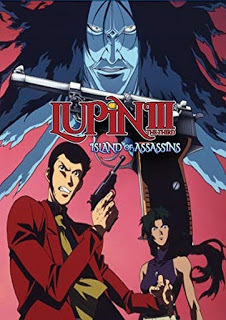 Lupin the Third: Island of Assassins, 1997, dir: Hiroyuki Yano
Lupin the Third: Island of Assassins, 1997, dir: Hiroyuki YanoMore than most franchises, Lupin the Third has a certain flexibility, so that while the average Lupin adventure is likely to be a comedic, frivolous affair with plenty of action, perhaps a bit of sexual innuendo, and not much in the way of weight or substance, none of that's baked into the essential formula. So it's no wonder that, the late nineties being what they were, someone thought it was time to take one of these many TV specials that were produced over the years in a somewhat grittier, more plot-driven direction.
The surprise, indeed, is how well it works, and also that director Yano found the right degree of restraint that the result still feels essentially like a Lupin entry. Though certainly the opening few minutes might lead you to believe otherwise, at least once they're done wrong-footing you into expecting everything to be business as usual. Lupin is heisting as only Lupin can when his arch-nemesis Inspector Zenigata ambushes him with a mob of policemen in tow, claiming Lupin was foolish enough to announce his crime in advice. But Lupin points out that he'd hardly do that, and in fact he's only here to find out who did, which is about when a bunch of tarantula-tattooed assassins burst in, violently murder a whole lot of people, and shoot poor Zenigata with a Walther P38, Lupin's weapon of choice.
Thankfully, the movie doesn't waste much time in trying to persuade us that Zenigata is genuinely dead, but there are plenty more shocks and twists to come, as Lupin and his consorts head off after the assassins, who come from the titular island of assassins, which happens to be the one-stop shop for hired killers in the world. Getting in proves easier than getting out, and the greater part of the plot sees Lupin striving to outwit the island's fiendish security systems, while following the lead provided by the Walther P38 and possibly stealing a huge quantity of gold along the way. All of that adds up to an unusually story-heavy entry with more drastic stakes than usual, and if I've a complaint, it's that more could have been done in that direction: in particular, a setup that finds Lupin forced into the league of assassins with little choice except to comply gets terribly squandered. And actually, now that I think, that's a symptom of a wider problem: there's scope for a darker take on the Lupin world, and Island of Assassins flirts hard with being that, but I can't help wondering if really digging into the morality of these characters might have yielded even more satisfying results. Notably, the artwork, though generally pretty fine, suffers from a similar flaw: the character designs never fully reconcile the classic look of our heroes with the more realistic take here, and the result is a number of shots where, splendid though the backgrounds and animation are, faces are somewhat odd and devoid of personality. The more severe Lupin we get glimpses of is an interesting take, but one the film isn't willing to commit to.
By the same measure, it's possible to imagine this exact same plot but with a touch more of the usual humour and action, and might that version perhaps have been more fun? I mean, not that Island of Assassins isn't, I'd hate to give that impression. Its first and last thirds, I would say, are among the best Lupin material I've seen, and if the middle sags slightly, it's probably a necessity brought on by setting up such an intricate final act. As such, I'd absolutely recommend this if you're a Lupin fan, and perhaps more so if you're not, because it's an excellent thriller in its own right and devoid of a lot of what I used to find so irritating before I warmed to the series. It's just a mite unsatisfying, that's all, an interesting experiment that might have yielded even more impressive results with a touch more commitment.
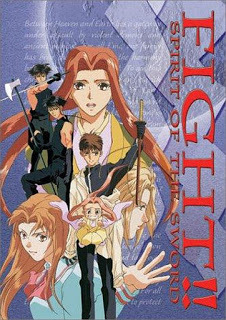 Fight!! Spirit of the Sword, 1993, dir: Ryô Yasumura
Fight!! Spirit of the Sword, 1993, dir: Ryô YasumuraYou have to wonder what AnimeWorks were thinking when they released Fight!! Spirit of the Sword. The obvious answer would be "money", except that it's hard to imagine a time when the anime market was so undercrowded that people would be rushing out to buy a thirty-minute-long OVA adapting a manga that I'm going to assume never made it to the West, and which I'm further assuming went under a different title - astonishingly, there's no Wikipedia page for Fight!! Spirit of the Sword. Oh, and yes, you read that correctly, AnimeWorks put out a release that was thirty minutes long including credits.
Now admittedly, that needn't be deathly. There are a couple of very short films in my collection that I treasure deeply; Cat Soup, for example, is a minor masterpiece despite its brevity. But Fight!! Spirit of the Sword ain't that. Instead, it's a wholly average, or perhaps slightly subpar, adaptation of something I suspect wasn't particularly inspired in the first place, and certainly comes across as a lot like a lot of other releases coming out of Japan at the time. Long story short - or rather, short story shorter! - our hero Yonosuke Hikura is the inheritor of a magical demon-fighting sword that's possessed by a spirit protector named Tsukinojo, who's either a grown woman or a big-eyed chibi version of a grown woman depending on what's happening, and who can't stray more than a few feet away from the jade hilt that the sword springs lightsaber-like from when it's in use. So it's no good thing when Yonosuke manages to lose the hilt, and therefore Tsukinojo with it, or when both fall into the hands of one of the demons they're meant to be fighting.
Even with that meagre length, it's easy to conceive of a version of Fight!! Spirit of the Sword that felt somewhat worthwhile, but sadly it's not the one the makers opted for. There are two ruinous mistakes, the first being to cram in way too much backstory and a side plot that goes nowhere, and the second being to make the big fight at the end an extraordinarily dull sequence in which Yonosuke flails at demons that resemble badly animated bursts of wind. That latter is really what brings the thing to its knees: a good climax would have taken the edge off the slenderness of what's on offer, since what's come before is pleasant enough, and director Yasumura shows a moderate amount of flare that keeps the mediocre animation from becoming a hindrance; heck, there's even one genuinely ingenious shot transition I've never seen done elsewhere, so hats off to him for that. But when it's all setup to nothing, it's difficult to remember the bits that were mildly engaging.
And here I am, wasting more time reviewing Fight!! Spirit of the Sword than I did watching it, when clearly it's utterly useless and not worth anyone even thinking about tracking down in this day and age. Well, except for one thing: the fifteen minute mini-documentary with the Japanese voice cast is actually kind of a fun time capsule if you're as obsessive about this stuff as I am, certainly more so than the non-event it's accompanying. Still, though, even given AnimeWorks' shameless lack of quality control elsewhere, this really is one for the record books, a release so contemptuous of its potential audience that it would take real effort to sink much lower.
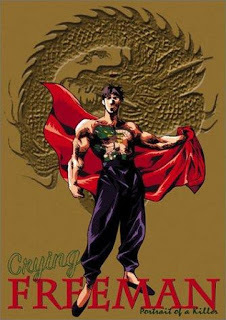 Crying Freeman: Portrait of a Killer, 1988, dir: Daisuke Nishio
Crying Freeman: Portrait of a Killer, 1988, dir: Daisuke NishioIt's a weird experience to watch an anime you only know from a live-action adaptation, but it's an even weirder one, especially if you're a committed fan of the animation medium, to discover that the live-action version is notably better. And here I should admit a degree of bias, since I've a long-term fondness for director Christophe Gans' Mark Dacascos-starring 1995 take on the material, and up until Alita Battle Angel appeared, would cheerfully have declared it the best anime adaptation ever made, despite the wholesale manner in which it plays fast and loose with the Japaneseness of the material. Nevertheless, I'm being as objective as I can, and the fact remains: Crying Freeman the movie is a vastly better interpretation, pilfering what works, discarding what doesn't, and inventing much necessary connective tissue to hold together some whopping narrative gaps.
Both tell essentially the same story, that of Yō Hinomura, a potter forced into the role of assassin, and his romance of sorts with Emu Hino, whom he inadvertently lets witness his bloody work not once but twice and then can't bring himself to do away with like everyone thinks he ought to. In the anime, this is largely a delivery system for lots of violence and nudity, which would be fine so far as it went, except that the animation is bland and the character designs are overly simple, shooting for the relative realism of the source manga and missing by a mile. The result is fight scenes that aren't terribly exciting and a couple of sex scenes that are about as titillating as doing the ironing. (In fairness, this was a failing of Gans' take, too, there's only so much you can do to redeem a sex scene when one of the parties is fully expecting to be murdered straight afterwards and just wants to lose their virginity while they can.)
With all of that together, plus a mismatched and uninspiring score, and then the fact that I've watched this same story told with a great deal more panache, you can imagine how the first fifty-minute-long episode on this, the first of three disks ADV released, didn't blow me away. So that even though the second episode is objectively worse, and much sillier, and probably quite offensive toward the mentally ill, obese people, women, and maybe the Chinese and Japanese as well, given that all the characters behave idiotically to a greater or lesser degree, I at least got a bit of enjoyment out of how dumb and weird it all was. Also, we finally get a bit of shading, which makes the animation look somewhat less cheap than it continues to be, so there's that.
Of course, it's unfair to be dismissive of an anime OVA for not being a live-action film that succeeds in part by heavily ripping off the best parts of said anime, and I suppose the reasonable thing to do would be to try and predict how this would play for the viewer new to the story. But I honestly can't see how it would make much difference. The OVA version, Portrait of a Killer, simply doesn't work, hammering through its tale at such a pace that it's never clear what anyone's motivations are, least of all the organisation Hinomura is enslaved to, who seem to function as villains or allies based on what the narrative needs at any given moment. In this version, it's simply a bad story told badly, and ugly to boot, and while that doesn't preclude the odd good scene or cool-in-a-late-eighties-way explosion of violent action, it also doesn't warrant your time.
-oOo-
On a side note, yeah, I know it makes zero sense that two of the titles here are actually from the eighties when I literally just put up a post focusing on eighties titles in isolation. But remember how I said there that all four felt like they belonged to a different era in a way nineties anime tends not to? Well, that's not true of Fight! Iczer One, which feels startlingly fresh, and for all its copious flaws, not really true of Crying Freeman either, I guess since there's a certain timeless quality to crummy anime. Which, by the way, we still have two more disks of to get through, so there's something to look forward to...
[Other reviews in this series: By Date / By Title / By Rating]



